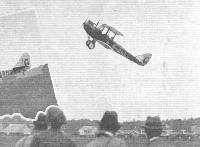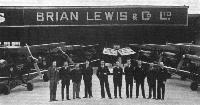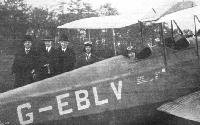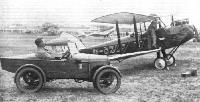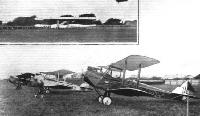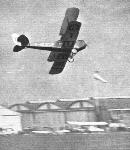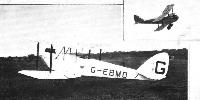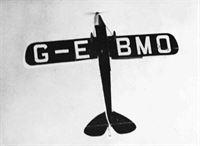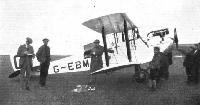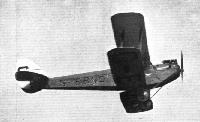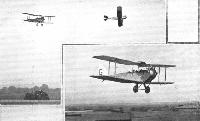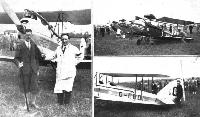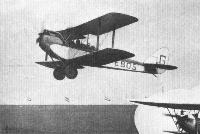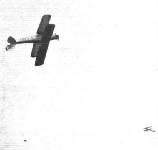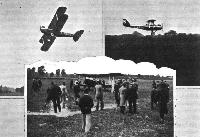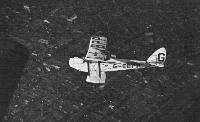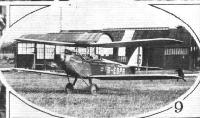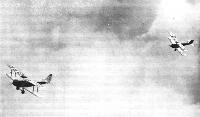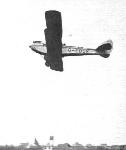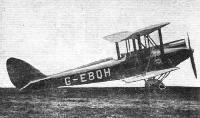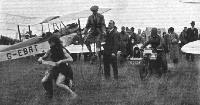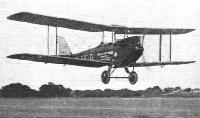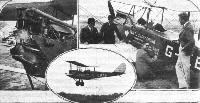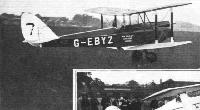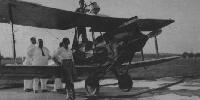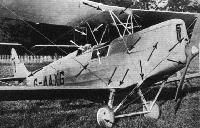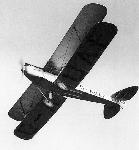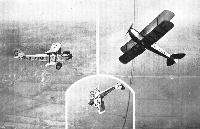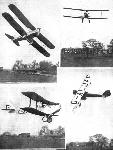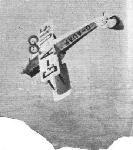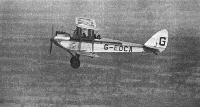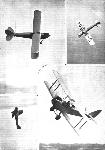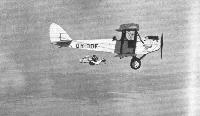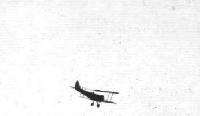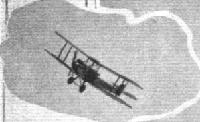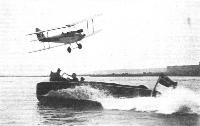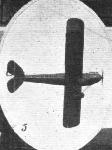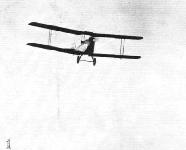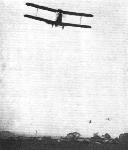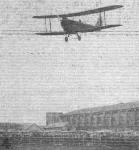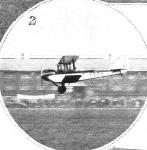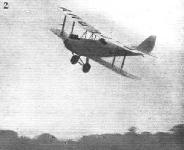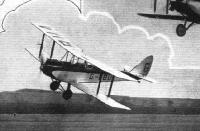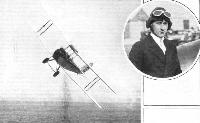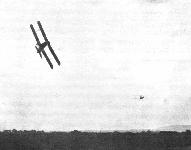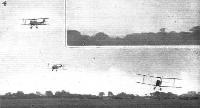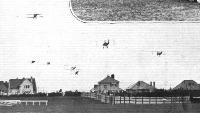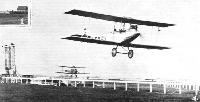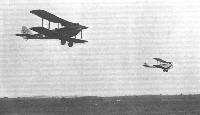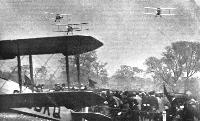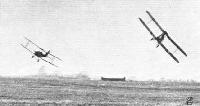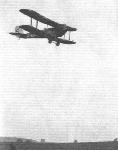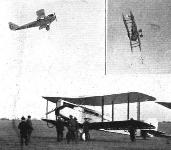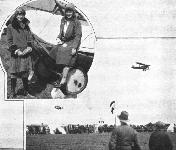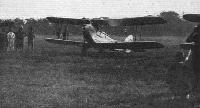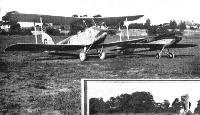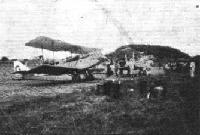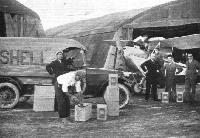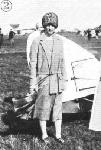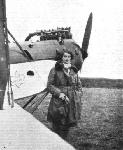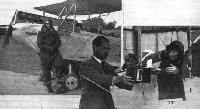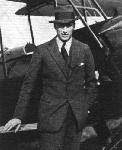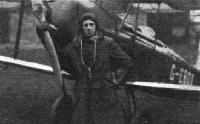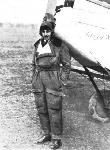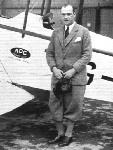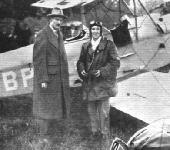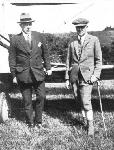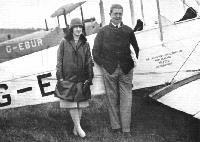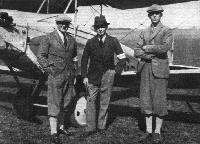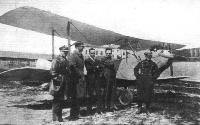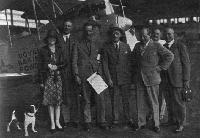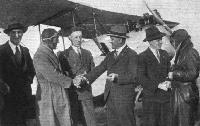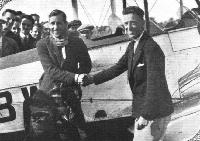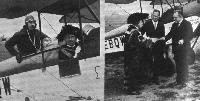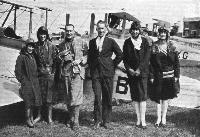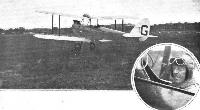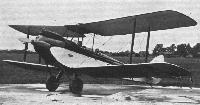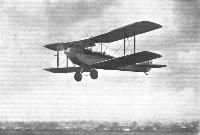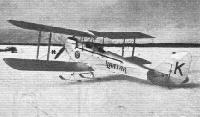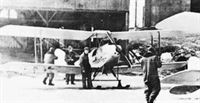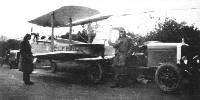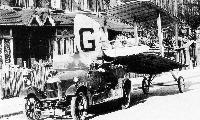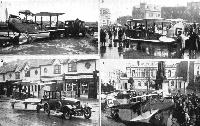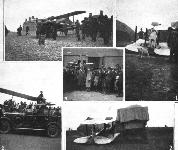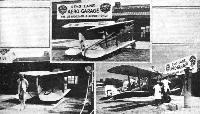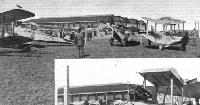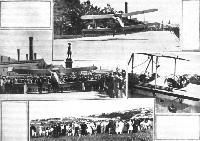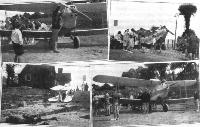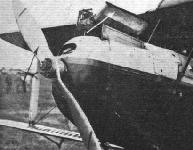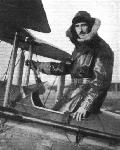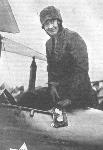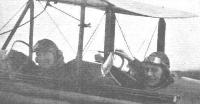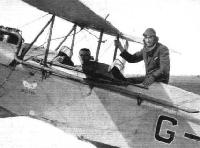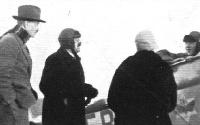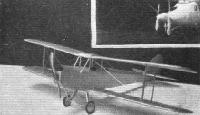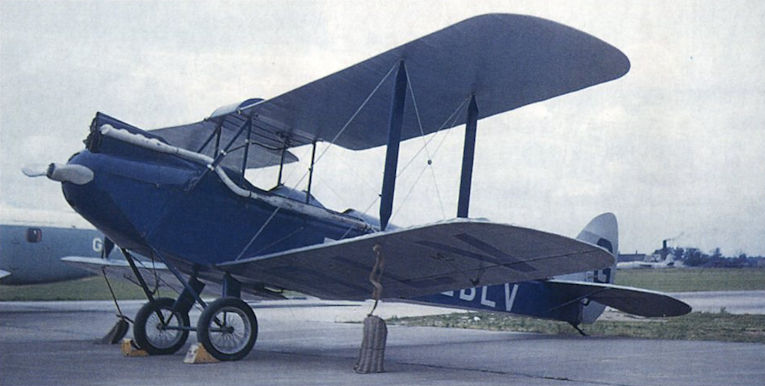
Варианты
- De Havilland - Moth / D.H.60 - 1925 - Великобритания
- De Havilland - Genet Moth - 1926 - Великобритания
- De Havilland - Moth Seaplane - 1926 - Великобритания
- De Havilland - Gipsy Moth / Moth X - 1928 - Великобритания
- De Havilland - Moth Coupe - 1928 - Великобритания
- De Havilland - Moth Major / D.H.60GIII - 1932 - Великобритания
de Havilland DH.60 Moth
Идея относительно дешевого самолета для небогатых людей привлекала авиастроителей во все времена. Одним из первых примеров успешной реализации этой концепции стал аэроплан DH.60 Moth, который положил начало целому семейству самолетов Moth, в корне изменившему британскую авиацию в 1920-1930 годах. Прототип DH.60 впервые взлетел 22 февраля 1925 года с рядным мотором ADC (Airdisco) Cirrus I мощностью 60 л.с. (45 кВт) - фактически "половинкой" V-образного мотора Airdisco мощностью 120 л.с. (90 кВт). Аэроплан оказался настолько удачным, что Министерство авиации решило субсидировать пять аэроклубов, оснащенных этими машинами. Первые из них поставили аэроклубу Ланкашира в июле 1925 года, всего через пять месяцев после полета прототипа. В тот год построили 20 DH.60, на следующий год - 35. Вскоре к британским заказчикам прибавились покупатели из Австралии и Японии. Последовали и военные заказы от Министерства авиации и авиакорпуса Ирландии. После демонстрационных полетов Алана Кобхэма на гидросамолете Moth в США там заключили договор о серийном производстве машины.
В 1926 году мотор Cirrus форсировали до 85 л.с. (63 кВт), назвали его Cirrus II и установили на DH.60. Одну машину построили для проведенного в 1926 году Министерством авиации конкурса легких самолетов в Лимпне, оснастив ее звездообразным мотором Armstrong Siddeley Genet мощностью 75 л.с. (60 кВт). Позже ее использовали для высшего пилотажа. Модель следующего года DH.60X снова улучшили, увеличив размах и присвоив название Cirrus II Moth.
Были установлены рекорды, совершены дальние перелеты, заказы продолжали поступать. Центральная летная школа ВВС закупила шесть экземпляров машины с моторами Genet, авиакорпус Ирландии - еще две. Cirrus II Moth также поставлялись многочисленным иностранным заказчикам.
<...>
Описание:
- de Havilland DH.60 Moth
- Flight, March 1925
THE DE HAVILLAND "MOTH” - Flight, January 1927
THE 1927 MODEL "MOTH" - Flight, July 1928
THE DE HAVILLAND D.H. 60 X "MOTH”
Фотографии
-
Мировая Авиация 25
Регистрационный номер: G-AAAH [9] Эми Джонсон назвала свой DH.60G Gipsy Moth "Ясоном" в честь героя греческой мифологии. Это четвертый серийный самолет, построенный для дальнего перелета в Кисиму, Кения, в 1928 году.
-
Air-Britain Archive 1980-02
Регистрационный номер: G-EBQV [2] -
Air-Britain Archive 1980-03
Регистрационный номер: G-EDCA [2] One of the earliest fixed registrations, G-EDCA was used by the Director of Civil Aviation, Sir Sefton Branker. The letter 'G' was repeated on top of the tailplane.
-
Air-Britain Archive 1980-04
Регистрационный номер: G-CALC The London Flying Club's G-CALC was silver overall with black lettering. The nationality letter G also appeared on the tailplane upper surfaces.
-
Air-Britain Archive 1980-03
Регистрационный номер: J9105 Cliff Minney's drawing shows J-9105 in silver overall with white outline around serials and fuselage roundel.
-
Air-Britain Archive 1980-04
C/n 646 in RCAF colours of silver overall with black cowlings and serials.
-
Air-Britain Archive 1987-04
Регистрационный номер: MO-102 Cliff Minney's drawing shows MO-102 in wartime olive drab fuselage and wing upper surfaces, sky blue undersurfaces, yellow band on fuselage and under wingtips and blue on white swastika.
-
Air-Britain Archive 1980-04
Регистрационный номер: OY-DOF [2] From Cliff Minney comes this view of c/n 249 featured in the first part of this series. Cliff comments that OY-DOF was used for parachute demonstrations and has a modified front cockpit apparently with some form of fuselage protection. The fuselage was white and the wings and tail were silver.
-
Aeroplane Monthly 2000-02 / J.Stroud - A million miles flown /A lifetime of flying/
Регистрационный номер: G-EBLV [12] The de Havilland D.H.60 Cirrus Moth G-EBLV at Hatfield on June 9, 1960. Built in 1925 as the eighth Moth constructed, ’LV was delivered to the Lancashire Aero Club in August that year. It is still airworthy, with the Shuttleworth Collection.
-
Мировая Авиация 25
Регистрационный номер: G-EBLV [12] Самый старый сохранившийся DH.60 Moth, G-EBLV, был шестым серийным самолетом и одним из двух, поставленных аэроклубу Ланкашира в августе 1925 года. Восстановленный в 1951 году стажерами фирмы "de Havilland", самолет и поныне находится в летном состоянии, а его владельцем является современный преемник "de Havilland" - компания "BAE Systems".
-
Aeroplane Monthly 1992-07 / D.Muscroft - Shuttleworth sunday
Регистрационный номер: G-EBLV [12] British Aerospace’s D.H.60 Moth G-EBLV looking resplendent after a major facelift by the Shuttleworth Collection. The world’s oldest airworthy Moth is seen in the hands of BAe test pilot Peter Tait.
-
Aeroplane Monthly 1994-04 / 1994 UK Aircraft Collections and Museums Guide
Регистрационный номер: G-EBLV [12] This typical Shuttleworth line up includes the Blackburn Monoplane, Roe IV Triplane, D.H. Moth G-EBLV (owned by BAe), Avro 504K and Bristol F.2B.
Другие самолёты на фотографии: Avro Avro 504 - Великобритания - 1913Avro Triplane IV - Великобритания - 1910Blackburn Mercury / Type D / Type E - Великобритания - 1911Bristol F.2A/F.2B Fighter - Великобритания - 1916
-
Aeroplane Monthly 1996-07 / 1996 UK Aircraft Collections and Museums Guide (1)
Регистрационный номер: G-AAAH [9] D.H.60 Moth G-AAAH Jason, Science Museum, South Kensington
-
Мировая Авиация 63
Регистрационный номер: G-EBKT [17] 2 февраля 1925г.: первый полет выполнил двухместный биплан de Havilland DH.60, G-EBKT, поднятый в воздух Джеффри де Хевилендом и положивший начало удачному семейству самолетов de Havilland Moth. 29 мая Алан Кобхэм пролетел на первом прототипе 1609 км от Кройдона до Цюриха и обратно зо один день. В июле самолет принял участие в гонках на Королевский кубок. Жизнь этого аэроплана была недолгой - он разбился в 1927 году.
-
Flight 1937-04 / Flight Advertisements
Регистрационный номер: G-EBKT [17] The Original "CIRRUS" Mark I Number 1 in the first D.H. "MOTH."
-
Flight 1937-05 / Flight
Регистрационный номер: G-EBKT [17] Makers of light plane history. The first D.H. 60 Moth, G-EBKT, with 60 h.p. Cirrus engine. This machine was De Havilland's interpretation of what a light aeroplane should be like. The machine was produced in 1925.
-
Flight 1925-07 / Flight
Регистрационный номер: G-EBKT [17] Two De Havilland "Moths" with 65 h.p. "Cirrus" engines are taking part in the King's Cup race. One has been entered and will be piloted by Cap. G de Havilland, and the other has been entered by Sir Charles Wakefield and will be flown by Mr. Alan J. Cobham. The machine shown in our photograph is the one entered by Sir Charles Wakefield.
-
Flight 1925-03 / Flight
Регистрационный номер: G-EBKT [17] THE DE HAVILLAND "MOTH": Three-quarter front, side, and three-quarter rear views, and, inset, the machine in flight
-
Flight 1925-06 / Flight
Регистрационный номер: G-EBKT [17] LONDON-ZURICH AND BACK IN A DAY: The De Havilland "Moth" (D.H. 60) light 'plane, fitted with a 60 h p "Cirrus" engine, on which Alan Cobham flew from London to Zurich and back in a day. The "Cirrus," which is manufactured by the Aircraft Disposal Co., is a 4-cyl. "in line" (vertical) air-cooled engine.
-
Air-Britain Archive 1980-01
Регистрационный номер: G-EBKT [17] The first of the line: G-EBKT the prototype Moth in its original configuration with clear doped wings, unbalanced rudder and starboard exhaust pipe.
-
Air-Britain Archive 1988-03
Регистрационный номер: G-EBKT [17] The first Moth G-EBKT c/n 168 showing the high-mounted Cirrus I engine with RH exhaust pipe crossed over from the LH exhaust ports and manifold, RH carburetter intake and induction manifold and in front the rounded 'bull' nose. Two instruments are mounted externally behind the engine, almost certainly Oil Pressure Gauge and RPM Indicator. Other features of the prototype in its initial form are the lack of a refuelling step and the unbalanced rudder.
-
Flight 1925-03 / Flight
Регистрационный номер: G-EBKT [17] THE D.H. "MOTH": The machine being seen having its wings spread from the folded position in readiness for flight
-
Flight 1925-07 / Flight
Регистрационный номер: G-EBKT [17], G-EBKU THE KING'S CUP: The first away on Friday were two D.H.60 "Moths" - G-EBKT, piloted by A. J. Cobham, and G-EBKU, piloted by Capt. de Havilland - shown taking off.
-
Flight 1925-03 / Flight
Регистрационный номер: G-EBKT [17] THE D.H. "MOTH": The machine being seen in full flight, photographed from another aeroplane.
-
Flight 1926-03 / Flight
Регистрационный номер: G-EBKT [17], G-EBLI EXAMINING THE ESCORTS: Visitors surround the D.H. "Moths," six of which went out to meet Cobham over Sevenoaks, one of them, piloted by Capt. Geoffrey de Havilland, carrying Mrs. Cobham. Owing to poor visibility, the "Moths" failed to get close to Cobham's machine, and arrived back at Croydon some little time after Cobham had landed.
-
Flight 1927-08 / Flight
"CRAZY-FLYING" AT NOTTINGHAM: Sqdn.-Leader Jack Noakes demonstrating the error of ordinary aerodynamic theory on the first de Havilland "Moth" ever built, the faithful old "Katie" (KT).
-
Flight 1934-05 / Flight
FROM ANCIENT TO ULTRA-MODERN: The Midland Club takes "official" delivery of its new "Moth Majors" and hands over the historic "Cirrus Moths." "LT," with wings folded, is probably the oldest "Moth" in the country.
Другие самолёты на фотографии: De Havilland Moth Major / D.H.60GIII - Великобритания - 1932
-
Flight 1925-08 / Flight
Регистрационный номер: G-EBLU OPENING OF LONDON AEROPLANE CLUB: Sir P. Sassoon about to make a flight in one of the "Moths," with Mr. Sparks as pilot.
-
Flight 1925-11 / Flight
Регистрационный номер: G-EBLV [12] At the Lancashire Aero Club Aerodrome: Behind the De Havilland "Moth" are seen Sir Charles Wakefield, Bart., President of the L.A.C.; Mr. John Leeming, Chairman of the Club; Sir Samuel Hoare, Secretary of State for Air; Mr. Cantrill, one of the club's flying instructors. In the cockpit, Mr. Scholes, the club's chief instructor.
-
Air-Britain Archive 1988-03
Регистрационный номер: G-EBLV [12] G-EBLV c/n 188, although the eighth Moth to be built and the oldest survivor, has been kept flying by modifications which make it a cross between a Cirrus I Moth with the early humped fuel tank and straight-axle undercarriage, a DH60X with the lowered engine mounting, and a Cirrus III Moth with the exhaust pipe inside the first centre-section strut. Another later feature is the prominent scoop and cover assembly projecting upwards over the tops of the cylinders.
-
Air-Britain Archive 1980-01
Регистрационный номер: G-EBLV [12] The rebuilt and restored G-EBLV c/n 188 at White Waltham in 1953
-
Aeroplane Monthly 1977-11 / R.Brett - My first solo
Регистрационный номер: G-EBLV [12] The Shuttleworth Trust’s D.H.Moth G-EBLV over Old Warden in June 1974.
-
Aeroplane Monthly 1978-04
Регистрационный номер: G-EBLV [12] D.H.60 Moths G-EBLV and G-ATBL photographed from a third near Old Warden by Air Portraits.
Другие самолёты на фотографии: De Havilland Gipsy Moth / Moth X - Великобритания - 1928
-
Aeroplane Monthly 1974-09 / News Spotlight
Регистрационный номер: G-EBLV [12] Hawker Tomtit K1786 and DH Moth G-EBLV.
Другие самолёты на фотографии: Hawker Tomtit - Великобритания - 1928
-
Air-Britain Archive 1988-03
Регистрационный номер: G-EBLW [3] G-EBLW c/n 189, the ninth Cirrus I Moth showing the high engine position of the early production machines, RH side carburetter intake, high LH exhaust manifold and exhaust pipe routed down the LH side. The production balanced rudder can be seen and painted on the nose is 'MIDLAND AERO CLUB No.2' (No.1 was G-EBLT c/n 186). The two air inlet holes under the propeller boss appeared on many of the early aircraft, approximately in line with the ends of the longer oil-breather pipes which were on some of the early Cirrus I engines. Prior to the first DH60X the base of the fuel tank was in line with the lower wing surface giving a humped appearance.
-
Flight 1926-07 / Flight
Регистрационный номер: G-EBLW [3] THE "MIDLAND MOTH": Capt. W. J. McDonough and the green D.H. "Moth" entered by Maj. Gilbert Dennison (Midland Aero Club). McDonough put up a plucky fight, and stuck it to the bitter end.
-
Air-Britain Archive 1988-04
Регистрационный номер: G-EBME DH60 G-EBME c/n 193 won the 1927 King's Cup held on the August Bank Holiday piloted by W.L.Hope. Racing modifications visible are removal of the long exhaust pipe from the Cirrus I, the covered over front cockpit containing the main fuel tank, and the special cover for the rear cockpit leaving a smaller opening for the pilot's head. On 21.7.28 Hope again won, this time in DH60G G-EBYZ, making the Moth winner of the King's Cup race for three years in succession.
-
Flight 1927-06 / Flight
Регистрационный номер: G-EBMF [7] "Hurry up Sparkie": Mr. R. A. Loader, while seated in his megaphone, shouts instructions through his "Austin Seven."
-
Flight 1927-06 / Flight
Регистрационный номер: G-EBMF [7] THE RACE FOR THE LADIES' PURSE: The photograph shows the three machines lined up for the start
-
Flight 1928-05 / Flight
Регистрационный номер: G-EBMF [7] Flying in a Thunderstorm: Mr. S. F. Mathews during the Talbot O'Farrell Race, flying "Moth" MF, an old-timer with Mark I "Cirrus" engine.
-
Flight 1926-07 / Flight
Регистрационный номер: G-EBMO [9] THE WINNER OF THE FIFTH KING'S CUP RACE: Capt. H. S. Broad takes off on the white and red D.H. "Moth" at the start on Friday. Inset, the "Moth" is shown "Crossing the line" at the finish on Saturday.
-
Flight 1926-09 / Flight
Регистрационный номер: G-EBMO [9] THE LYMPNE OPEN HANDICAP: 5. The white de Havilland "Moth."
-
Air-Britain Archive 1988-04
Регистрационный номер: G-EBMO [9] DH60 G-EBMO c/n 197, in which the 1926 King's Cup was won by Hubert Broad on 10th July, in single-seat racing format fitted with the first Cirrus II engine with stub exhausts. The unmistakable Moth tailplane shape is silhouetted in this view, each side being a near duplicate of the fin and rudder shape. In pre-war years the King's Cup was a 'round-Britain' race averaging over 1000 miles.
-
Flight 1926-10 / Flight
Регистрационный номер: G-EBMO [9] Land's End to John O'Groats in a "Moth": Colonel the Master of Sempill enjoys a refreshing cup of tea after his recent flight from Land's End to John O 'Groats in the King's Cup D.H. "Moth" G-EBMO. He covered the 630 miles in 8 hrs. 14 mins., making a brief halt at Shotwick en route.
-
Air Pictorial 1992-02 / P.Jarrett - Karachi collection
Регистрационный номер: G-EBMO [9] DE Havilland Cirrus I Moth G-EBMO, piloted by Hubert Broad, won the 1926 King’s Cup Race. It was subsequently fitted with the first production Cirrus II engine of 85 h.p. and, on 16 November, left Croydon for India, flown by T. Neville Stack and accompanied by B. S. Leete in G-EBKU, the second prototype Moth. After reaching India in December the two Moths - the first to be seen in the subcontinent - went on a joyriding tour. G-EBMO was sold in India in June 1927, and ’KG crashed at Calcutta the following month. Stack (left) and Leete are seen here with ’MO in front of a rather distinctively marked hangar.
-
Flight 1926-09 / Flight
Регистрационный номер: G-EBLR, G-EBMO [9] THE LANCASHIRE AIR PAGEANT: Line-up of six "Moths" for the start of the Inter-Club Members' Race. This was won by Mr. Lacayo, on the Lancashire Aero Club's G-EBLV.
-
Flight 1927-09 / Flight
Регистрационный номер: G-EBMO [9] Hooton Air Pageant: Mr. R. Williams dropping over the temporary fence in the landing competition on Moth "MQ". His fellow club member, Mr. Costa, tried on the same machine, and got second place to Mr. Will Hay.
-
Flight 1926-04 / Flight
Регистрационный номер: G-EBMO [9] FLYING AT MANCHESTER: Bombing the Arab Fort at the L.A.C. Display; left, a "Moth" makes a machine-gun attack: right, the Arab "scouts" during a lull in the attack.
-
Flight 1926-02 / Flight
Регистрационный номер: G-EBMO [9] At Stag Lane Aerodrome on Tuesday of this week, Sir Charles Wakefield, Bart., presented to representatives of the Lancashire Aero Club the de Havilland "Moth" generously promised the Club at a luncheon in Manchester in November last. In our group will be recognised Colonel Edwards of the Air Ministry, Sir Charles Wakefield, Commander H. Perrin, Mr. John Leeming, Chairman of the'Lancashire Club, and Colonel Darby, whose firm built the "Cirrus" engine with which the "Moth" is equipped. The flying pictures show the "Moth" being stunted by Capt. Broad, the well-known de Havilland pilot.
-
Aeroplane Monthly 1982-05 / P.Capon - Stag Lane /Capon's Corner/
Регистрационный номер: G-EBMP G-EBMP on its nose after an incident at Stag Lane, possibly in 1926. Inset "D.H." himself. Geoffrey de Havilland seated in a Moth of the Newcastle upon Tyne Aero Club at Stag Lane.
-
Air-Britain Archive 1980-02
Регистрационный номер: G-EBMQ The ill-fated G-EBMQ in Lancashire Aero Club colours at Woodford between mid-1932 and mid-1934. The photo can be dated by the presence of Tutors G-AARZ and G-ABZP in the hangar behind the Moth.
-
Flight 1927-05 / Flight
Регистрационный номер: G-EBMU [3] AN EASTER TOUR ON A D.H. "MOTH": These photographs show Mr. D. Kittel in the cockpit of his machine, and inset, starting on his flight.
-
Aeroplane Monthly 1979-04 / Stag Lane /Gone but not forgotten/ (1)
Регистрационный номер: G-EBMU [3], G-EBMV [4], G-EBOT [3], G-EBQX [3], G-EBQY [2], G-EBQZ [3] 20 Moths basking in the summer sun, lunchtime, June 3, 1927.
-
Flight 1927-08 / Flight
Регистрационный номер: G-EBMU [3], G-EBMV [4], G-EBOT [3], G-EBPU [8], G-EBQX [3], G-EBQY [2], G-EBQZ [3] MASS PRODUCTION AT STAG LANE: This assembly of twenty "Moths" was taken at Stag Lane recently, and with the exception of getting them lined up no previous arrangements had been made for their presence. The group includes those owned by Lady Bailey, Lord Ossulston, the Hon. Geoffrey Cuncliffe, Capt. W. R. Bailey, Mr. D. Kittel and Capt. Eric Hayes.
-
Air-Britain Archive 1988-03
Регистрационный номер: G-EBNO [9] G-EBNO c/n 261 showing early steps taken to improve performance for racing: single seater with front cockpit covered over and long stub exhausts enclosed in a flat fairing with a streamlined tail. This fairing was used as late as the 1929 King's Cup (on G-EBPQ c/n 357) but disappeared when shorter stubs were used without problems in the cockpit. The humped fuel tank and large wheels were unchanged.
-
Flight 1927-02 / Flight
Регистрационный номер: G-EBNO [9] FLYING IN 1909 AND STILL GOING STRONG: Capt. Geoffrey de Havilland, one of our pioneer designers and pilots, still flies whenever there is an opportunity. He is here seen on one of the "Moths," having a look at the recent snow from above.
-
Flight 1926-07 / Flight
Регистрационный номер: G-EBNO [9] "Designer, Entrant, and Pilot, too!": Capt. G. de Havilland not only entered one of his "Moths" for the King's Cup Race, but flew it himself. This machine had a new "Cirrus II" engine, and Capt. de Havilland was making excellent progress until forced out of the race by a very minor defect - a broken oil pipe.
-
Flight 1926-08 / Flight
Регистрационный номер: G-EBNO [9] THE BOURNEMOUTH AVIATION MEETING: The Ensbury Park Low Power Handicap (Saturday). Top, Mrs. Eliott-Lynn (right) and S.L.F. St. Barbe flying their "Moths," in the first heat. Bottom, Capt. de Havilland on his Cirrus II "Moth," winning the final of this race.
-
Flight 1927-02 / Flight
Регистрационный номер: G-EBNO [9] A D.H.50 FOR NEW ZEALAND: This machine has been ordered for survey work, the cabin being specially arranged for the taking of photographs. Our picture shows the 50 on a test flight, piloted by Captain Broad, shortly before its despatch to the Antipodes. In the background is seen a "Moth," piloted by Capt. Geoffrey de Havilland himself.
Другие самолёты на фотографии: De Havilland D.H.50 - Великобритания - 1923
-
Aeroplane Monthly 1981-09 / A.Wheeler - The Bournemouth Easter Meeting
Регистрационный номер: G-EBNX [2] THE "KILL-JOY" TROPHY: A line-up of the machines.
The line-up for the start of the “Kill-Joy” race with three S.E.5As at the far end.Другие самолёты на фотографии: RAF S.E.5 - Великобритания - 1916
-
Flight 1927-10 / Flight
Регистрационный номер: G-EBNY BRISTOL CLUB'S AIR DAY: These are two general views of the machines which took part at the meeting at Filton, giving an idea of how representative the machines were of the light aeroplane class.
Другие самолёты на фотографии: Blackburn Bluebird / L.1 - Великобритания - 1924Westland Widgeon - Великобритания - 1924
-
Flight 1926-08 / Flight
THE BOURNEMOUTH AVIATION MEETING: The line up for the first event on Sunday - the Private Club Handicap, won by Capt. de Havilland's "Moth" (the third machine on the left).
Другие самолёты на фотографии: De Havilland Humming Bird / D.H.53 - Великобритания - 1923
-
Flight 1927-07 / Flight
Регистрационный номер: G-EBOH [2] TO 18,000 FT.: The Honourable Lady Bailey (right), accompanied by Mrs. Geoffrey de Havilland, last week succeeded in establishing a new world's record for light 'planes by ascending to 18,000 ft. in a De Havilland "Moth X."
-
Air-Britain Archive 1985-03
Регистрационный номер: G-EBOI [3] A Hampshire Aeroplane Club Cirrus Moth G-EBOI which was later owned by the Cotswold Aero Club pre-war.
-
Flight 1927-05 / Flight
Регистрационный номер: G-EBOI [3] THE HAMPSHIRE AIR PAGEANT: Event 4, the Light Aeroplane Utility Race for the "Flight" Cup. The winners; (left), Flight-Lieut. G. I. Thomson and his passenger, Mr. McCracken, of the Hampshire Club. They wheeled their "Moth" out of its "hangar" (top), unfolded its wings, took off, flew one circuit, landed, re-folded, and pushed the machine back in the hangar (bottom) all in 7 mins. 14 secs.
-
Flight 1928-07 / Flight
Регистрационный номер: G-EBOS [2] AT THE ROTTERDAM LIGHT 'PLANE MEETING: The take-off and landing competition. 1. Miss O'Brien taking off.
-
Aeroplane Monthly 1988-12 / Personal album. Civil
Регистрационный номер: G-EBOT [3] D.H.60 Moth G-EBOT, built at Stag Lane in 1926 and first registered to the parent company on August 7. It is seen in a farmer's field at Bersted, near Bognor Regis, where owner Lionel Hill kept the Moth for a few months 'during 1929. Hill's brother is fuelling the Moth, his future wife is standing by the propeller and on the right is Charley Atkinson. What can one say about Charley?! He later became a parson.
-
Flight 1928-09 / Flight
Регистрационный номер: G-EBOU [5] One of the memories of the Orly meeting for the French and Germans (to judge from their impressions) will be of the stunting display of Flying-Officer Atcherley on the Genet-Moth, the first of that type ever constructed. (Inset left) Flying-Officer Atcherley, and (inset right) shows the machine in a slow roll, whilst in the centre is evidence of the reception he got after the display.
-
Flight 1928-10 / Flight
Регистрационный номер: G-EBOU [5] "STAR TURN" AT NORTHAMPTON: Flying Officer R. L. R. Atcherley in a conventional position (for him) on his back in Flight-Lieut. Soden's "Genet-Moth" "OU" during a roll. He "shot up" the large crowd at Syweil on Saturday in his usual way, diving low and clearing with climbing rolls.
-
Flight 1927-05 / Flight
Регистрационный номер: G-EBOU [5] THE MIDLAND CLUB "AT HOME": Two views taken on the occasion of a successful aerial "At Home," held last Sunday, at Castle Bromwich, showing some of the machines lined up for a handicap race for three cups presented by the Club Council.
Другие самолёты на фотографии: Westland Widgeon - Великобритания - 1924
-
Flight 1929-07 / Flight
Регистрационный номер: G-EBPQ SECOND AND ALSO FIRST: Lieut. L. G. Richardson, second in the King's Cup and first in the Siddeley Trophy, starting from Heston (left) and finishing. Below, Richardson and Atcherley being greeted on landing at Heston.
-
Flight 1927-11 / Flight
Регистрационный номер: G-EBPU [8] The President of the Suffolk Club, the Hon. Lady Bailey, is here seen in an active position on her own "Moth," in which she took a large share in the joyriding work that was carried out continuously at the meeting at Hadleigh.
-
Flight 1927-02 / Flight
Регистрационный номер: G-EBPM [2] DISFIGURATION: At the last House Dinner of the Royal Aero Club, Mr. C. R. Fairey referred to the manner in which the lines of an aeroplane are spoiled by registration letters. These two photographs rather bear out Mr. Fairey's contention. A motor car with registration letters "as large as the surface will permit" would probably not be easy to sell.
-
Flight 1927-01 / Flight
Регистрационный номер: G-EBPM [2] THE 1927 MODEL "MOTH": This three-quarter front view shows the type of machine that has been standardised for the present year, and which incorporates several refinements.
-
Flight 1928-05 / Flight
Регистрационный номер: G-EBPP Flying over Sydney: This photograph shows Maj. H. de Havilland, D.S.O., flying a "Cirrus-Moth" during his visit last year.
-
Flight 1927-07 / Flight
Регистрационный номер: G-EBPR [3] DE HAVILLAND SPORTS: Some snaps from a highly successful meeting. Giving 2s. 6d. joy rides on a "Moth"
-
Flight 1927-06 / Flight
Регистрационный номер: G-EBPR [3] TWO "MOTHS": Pope on PR leading Broad on QH in Hotels Association Sweepstake, first heat.
Другие самолёты на фотографии: De Havilland Moth / D.H.60 - Великобритания - 1925
-
Air-Britain Archive 1986-03
Регистрационный номер: G-EBPR [3], G-EBQZ [3], G-EBRI [5], G-EBRY [2], X5128 [5] While DH.60 Moth data continues to flow in almost unabated we can enjoy this view of the de Havilland factory at Stag Lane about 1928. Moths G-EBPR and G-EBRY share the foreground with DH.9J G-EBGT while G-EBQZ and G-EBRI are also identifiable beyond.
Другие самолёты на фотографии: De Havilland D.H.9B / D.H.9C - Великобритания - 1919
-
Flight 1927-11 / Flight
Регистрационный номер: G-EBQE SUFFOLK CLUB'S AIR DAY: (2) Capt. "Jerry" Shaw does his share of the joy-riding work in the Shell "Arom."
-
Flight 1929-11 / Flight Advertisements
Регистрационный номер: G-EBQH [5] G-EBQH. A high performance two-seater Moth, the property of Mr. A. S. Butler, Chairman of The de Havilland Aircraft Company Limited. Fastest time for light aircraft in King's Cup Race, 1929. Top speed 120 m.p.h. Standard Gipsy engine, racing undercarriage, Compass. Faired and streamlined throughout. C. of A. to September, 1930. Price ?575.
-
Flight 1927-06 / Flight
Регистрационный номер: G-EBQH [5] TWO "MOTHS": Pope on PR leading Broad on QH in Hotels Association Sweepstake, first heat.
Другие самолёты на фотографии: De Havilland Moth / D.H.60 - Великобритания - 1925
-
Aeroplane Monthly 1982-11 / P.Capon - Capon's Corner
Регистрационный номер: G-EBQH [5] The D.H.60X Moth prototype, G-EBQH, powered by a 90 h.p. A.D.C. Cirrus III engine, dropped into Hamble during the 1928 King’s Cup race, July 20/1, piloted by Capt Geoffrey de Havilland, seen in the cockpit. The D.H.60X was placed seventh. The X stood for experimental and the Cirrus engine's mountings were lowered and the airframe considerably modified internally.
-
Aeroplane Monthly 1988-03 / Personal album. Civil
Регистрационный номер: G-EBQJ D.H.60 Moth G-EBQJ, originally built at Stag Lane as a seaplane in 1927, was converted to a landplane and sold to Denis M. M. Rooke. The owner departed Croydon for Australia on May 24, 1927, for a bet. His luck ran out when the Moth hit a palm tree while taking off from Aurangabad on August 14. The Moth, named Margorie, was destroyed.
-
Aeroplane Monthly 1985-11 / H.Morris - The Barnstormer's Apprentice (1)
Регистрационный номер: G-EBRI [5], X5128 [5] Northern Air Transport's blue and silver D.H.60X Moth, G-EBRI, photographed at Barton in September 1932. In December 1939 'RI was impressed into the RAF as X5128.
-
Aeroplane Monthly 1987-04 / L.Curtis - The Flying Duchess (1)
Регистрационный номер: G-EBRI [5], X5128 [5] Getting ready to go home. The Duchess of Bedford and her pilot, Capt. C. D. Barnard, about to return after a flying visit to the Nottingham meeting.
D.H.60X Moth G-EBRI was the Duchess of Bedford's first aircraft. She owned it from May 1927 until October the following year, when it was replaced with Gipsy Moth G-AAAO. In this photo she is next to the Moth's tail. -
Flight 1928-10 / Flight
Регистрационный номер: G-EBRT PAGEANT OF PROGRESS: The leader is a "cave-man"with a "cave-man's" alleged form of transport, of which one doubts the historical accuracy. He is followed by the "penny-farthing" bicycle motor-cycle, racing car and Avro "Avian" piloted by Lady Heath.
-
Flight 1928-05 / Flight
Регистрационный номер: G-EBRY [2] A NEW PARACHUTE: The D.H. "Moth" was, as usual, ready to assist by providing a "wind" to open the parachute on the ground. In the group are Air Ministry representatives and other experts. Behind the cords and hatless is Mr. C. A. Pike, who piloted the D.H.9 for the occasion. Miss June, the well-known parachutist, is on the left facing the camera.
-
Air-Britain Archive 1985-03
Регистрационный номер: G-EBSN THE BRISTOL AIR PAGEANT: A portion of the "Parade." Nearest the camera is a de Havilland "Cirrus-Moth." Ahead of that a Westland "Cirrus-Widgeon," an Avro "Cirrus-Avian" and a Blackburn "Genet-Bluebird."
A collection of flying school aircraft at a meeting, probably in April or May 1928. From left to right we have G-EBXG DH.60X Moth with Handley Page auto slots which was to be used by the Nottingham Flying Club; G-EBSN another DH.60X of the Bristol & Wessex Aero Club; G-EBRO a Westland Wigeon 3; G-EBVU an Avro Avian 3 purchased about this time by Capt Henry D.Wolff; an SE.5A G-EBIB; G-EBOO the Halton Aero Club Mayfly; and G-EBJT a Westland Widgeon 2.Другие самолёты на фотографии: Avro Avian / Type 594/616 - Великобритания - 1926De Havilland Gipsy Moth / Moth X - Великобритания - 1928Halton H.A.C.1 Mayfly/H.A.C.2 Minus - Великобритания - 1927RAF S.E.5 - Великобритания - 1916Westland Widgeon - Великобритания - 1924
-
Aeroplane Monthly 1977-11 / R.Brett - My first solo
Регистрационный номер: G-EBSS Three months after the Cinque Ports Flying Club purchased D.H.Moth G-EBSS, a newly qualified pilot came to grief in it. He was aerobatting in the vicinity of Lympne and had completed two loops, but had difficulty recovering from a roll. While upside down he was thrown from the aircraft and killed. G-EBSS dived vertically into the ground close by.
-
Flight 1929-07 / Flight Advertisements
Регистрационный номер: G-EBTD [12] G-EBTD - это Moth, оснащенный двигателем Gipsy и налетавший около 600 часов в 1928-1929 годах при выполнении только текущего технического обслуживания. Такая надежность оказалась отличной рекламой для Gipsy Moth.
The photograph shows Capt. Broad behind the Sealed Gipsy Engine which has completed 502.3 flying hours (apart from running up and taxying, which is approximately another 43.75 hours) or 42,695 MILES. -
Aeroplane Monthly 1982-12 / B.Gunston - The classic aero engines (4)
Регистрационный номер: G-EBTD [12] During 1929 D.H.60 Moth G-EBTD was fitted with a sealed Gipsy I engine and flown for 600hr, covering a distance of 51,000 miles. The engine received only routine maintenance and at the end of the reliability test the cost of replacement parts was a little more than £7.
-
Aeroplane Monthly 1979-04 / ??? - The Famous Grouse DH Moth Air Rally
Регистрационный номер: G-EBTD [12] -
Aeroplane Monthly 1979-04 / Stag Lane /Gone but not forgotten/ (1)
Регистрационный номер: G-EBTD [12] The sealed Gipsy engine test Moth G-EBTD.
-
Flight 1929-11 / Flight Advertisements
Регистрационный номер: G-EBTD [12] G-EBTD. (The Reliability Tour Moth.) The identical Gipsy Moth which has just concluded the record total of 600 flying hours with completely sealed engine. Aircraft and engine now completely overhauled and reconditioned throughout. Telephones fitted. C. of A. for 12 months. A chance to acquire a machine which has made flying history, Price ?425.
-
Flight 1929-09 / Flight
Регистрационный номер: G-EBTD [12] Mr. Geoffrey de Havilland, Jr., adds a few more hours to EBTD's score.
-
Flight 1929-09 / Flight
Регистрационный номер: G-EBTD [12] 1,000 HOURS BETWEEN OVERHAULS: A few years ago this would have appeared out of the question. Yet the de Havilland "Gipsy" engine, in a "Moth," has just completed 600 hours, so that we are well on the way. One of these photographs shows, Mr. Eadon, who has sat behind the "Gipsy" during a large proportion of the 600 hours, is seen chalking up the final "hourage." Interested onlookers are Mr. Tuck, of the Hoyt Metal Co., who is interested in the bearings, Mr. Collins, an apprentice who has had much to do with the reliability test, and, on the right, G. de Havilland, Jun., one of several pilots who have helped to pile up a mileage of well over 50,000 miles. The "Gipsy" will now be put on the test bench to have power curves taken, and will then be stripped for examination.
-
Aeroplane Monthly 1979-04 / ??? - The Famous Grouse DH Moth Air Rally
Регистрационный номер: G-EBTD [12] Cowling and propeller removed, and seals still untouched.
-
Flight 1929-10 / Flight Advertisements
Регистрационный номер: G-EBTD [12] Starting to dismantle the engine.
-
Flight 1928-03 / Flight
Регистрационный номер: G-EBTD [12] A "MOTH" WITH AUTOMATIC SLOTS: Capt. Geoffrey de Havilland demonstrating a mistake often made by beginners: "Landing 10 ft. above the ground." Note that the elevators are hard up. In a normal machine a crash on a wing tip would almost certainly have followed. In this case the "Moth" merely bounced, and then settled quite comfortably.
-
Flight 1927-11 / Flight
Регистрационный номер: G-EBUF [7] AT HADLEIGH: On the left is the A.D.C. "Cirrus" Service "Moth" which was flown down by Capt. Stack with Mrs. Stack as passenger. On the right Capt. Stack is on the same machine giving his interesting exhibition of stunting.
-
Flight 1929-09 / Flight
Регистрационный номер: G-EBUF [7] "THE MASTER AND HIS MINIONS": Capt. T. Neville Stack, A.F.C., Chief Pilot and Air Superintendent, on the left in the Hermes Moth and on the right his pilots show the result of his organisation.
-
Air-Britain Archive 1988-03
Регистрационный номер: G-EBUF [7] Cirrus II Moth G-EBUF c/n 441 was initially a standard production DH60X with long exhaust pipe but is seen here with stub exhausts and a metal propeller as modified by the first owner ADC engine division who used it from 9.27 to 6.30 for Cirrus and Hermes development. Clearly seen in this photograph is the slight and easily overlooked trailing edge taper at the roots of all four mainplanes which was necessary to prevent the wings from fouling each other when folded.
-
Flight 1930-06 / Flight
Регистрационный номер: G-EBUF [7] Capt, Stack aerobating with his usual verve.
-
Air-Britain Archive 1988-04
Регистрационный номер: G-EBUF [7] G-EBUF c/n 441, straight-axle DH60X, now fitted with a close-cowled Hermes engine by ADC, In which form It was sold to S.Smith & Sons. The Hermes LH carburetter Intake hole at the front, the faired-over carburetter and the induction manifold above It can all be seen, and stub exhausts were fitted on the RH side. The windscreens have been modified to a non-standard 'tunnel' type.
-
Flight 1928-06 / Flight
Регистрационный номер: G-EBUR, G-EBXT [2] THE MIDLAND AIR PAGEANT: A portion of the machine park, and some of the crowd at Castle Bromwich Aerodrome.
Другие самолёты на фотографии: Sopwith Grasshopper - Великобритания - 1920
-
Flight 1929-04 / Flight Advertisements
Регистрационный номер: G-EBVK LT. COL. G. L. P. Henderson of the Henderson Flying School reports an excellent performance by a Cirrus Mark II engine which has just completed 260 hours without top overhaul. The fuel used throughout was Pratts. This is a splendid tribute to the purity and reliability of this famous motor spirit.
-
Aeroplane Monthly 1977-11 / R.Brett - My first solo
Регистрационный номер: G-EBWC [3] Although not a photograph taken during the authors first solo, this does show the actual D.H.Moth, G-EBWC, featured in this article. The aircraft was the de Havilland Company's' demonstration model, and is seen here in the capable hands of Hubert Broad during the Cinque Ports' Flying Club Easter Meeting at Lympne in April 1928.
-
Aeroplane Monthly 1977-11 / R.Brett - My first solo
Регистрационный номер: G-EBWC [3] Almost certainly another picture of ’WC at Lympne during Hubert Broad's demonstration flight in Easter 1928.
-
Aeroplane Monthly 1977-11 / R.Brett - My first solo
Регистрационный номер: G-EBWC [3] 'WC in company with Avro Avian G-EBWU at Lympne. On July 7, 1928, a club member taxied 'WC, “at great velocity into one of the permanent hangars. The hangar proved to be more permanent than the Moth, which looked uncommonly like a write-off”.
Другие самолёты на фотографии: Avro Avian / Type 594/616 - Великобритания - 1926
-
Air-Britain Archive 1988-01
Регистрационный номер: G-EBWV The long-range Moth with Capt Geoffrey de Havilland in trilby and heavy-duty flying suit. The upper wing fuel tank filled the centre section completely, small wheels were fitted and the fuselage forward of the cockpit was modified and irregularly painted. Part of the registration G-EBWV can be seen.
-
Aeroplane Monthly 1988-12 / Personal album. Civil
Регистрационный номер: G-EBWZ Pictured at Shoreham in June 1928 is D.H.60X Moth G-EBWZ, built at Stag Lane the same year and first registered to Henry Petre ("Peter the monk") after the first C of A was granted on March 15. G-EBWZ's last owner was Mrs Marjorie Stevens who kept the Moth at Brooklands from December 1929. A month or so later 'WZ crashed and the marks were cancelled in January 1930.
-
Air-Britain Archive 1987-01
Регистрационный номер: G-EBOI [3], G-EBXT [2] Midland Aero Club Cirrus Moth G-EBXT, with G-EBOI in the background.
-
Flight 1928-08 / Flight
Регистрационный номер: G-EBYK [2] THE HALTON PAGEANT: Capt. Broad taking off in his cleaned-up King's Cup "Gipsy-Moth."
-
Aeroplane Monthly 1980-03 / Plane Crazy
Регистрационный номер: G-EBYK [2] -
Flight 1928-07 / Flight
Регистрационный номер: G-EBYZ [2] SOME MORE COMPETING MACHINES: The winning D.H. "Moth" (D.H. "Gipsy"), piloted by W. L. Hope. Hope's "Moth" is fitted with the new de Havilland "Gipsy" engine, of which three were entered and all of which completed the course.
-
Flight 1928-07 / Flight
Регистрационный номер: G-EBYZ [2] THE FINISH OF THE KING'S CUP AIR RACE: Capt. W. L. Hope "crossing the line" at Brooklands on his D.H. "Moth" (D.H. "Gipsy")
-
Aeroplane Monthly 1994-02 / M.Roffe, D.Baker - Great moments in aviation (4)
Регистрационный номер: G-AAAH [9] G-AAAH, built at Stag Lane in 1928, was the fourth production Gipsy Moth and was registered on August 30 to Capt Walter L. Hope.
-
Aeroplane Monthly 1986-01 / 1986 UK Aircraft Collections and Museums Guide
Регистрационный номер: G-AAAH [9] Amy Johnson with D.H Gipsy Moth G-AAAH Jason at Sourabaya in May 1930.
-
Flight 1930-08 / Flight
Регистрационный номер: G-AAAH [9] AN ECHO OF A GREAT FLIGHT: A snap of Miss Amy Johnson taken at Sourabaya while her D.H. "Moth" was having its tanks replenished with "Shell" motor spirit.
-
Aeroplane Monthly 1994-02 / M.Roffe, D.Baker - Great moments in aviation (4)
Регистрационный номер: G-AAAH [9] An officer helps to start Jason’s Gipsy engine at Jhansi, India on May 12, 1930, some 5,000 miles into Amy’s flight to Australia which began at Croydon on the morning of May 5.
-
Flight 1930-05 / Flight
Регистрационный номер: G-AAAH [9] At Jhansi: An officer helps to start Miss Johnson's engine.
-
Aeroplane Monthly 1985-04 / N.Ewart - When flying was still an adventure (1)
Регистрационный номер: G-AADB [2] D.H. 60 Moth G-AADB, the author's favourite, began life as the American Naval Attache's personal aircraft, based at Stag Lane.
-
Aeroplane Monthly 1974-02 / Skywriters
Регистрационный номер: G-AADB [2] Airspeed Courier G-ABXR takes on fuel from Handley Page W.10 tanker G-EBMR in 1934, watched by D.H.60 Moth G-AADB.
Другие самолёты на фотографии: Airspeed Courier / AS.5 - Великобритания - 1933Handley Page H.P.18 (W.8) / H.P.30 (W.10) - Великобритания - 1919
-
Flight 1929-07 / Flight
Регистрационный номер: G-AAHP FIRST TWICE, NOW THIRD: Last year's winner, Capt. W. L. Hope, seen on the right, looks far from displeased, although he came in third for the King's Cup and second for the Siddeley Trophy. On the left, starting from Heston.
-
Flight 1930-07 / Flight
Регистрационный номер: G-AAXG Mr. Butler's "Moth" (Gipsy II), No. 76, was "cleaned up" with extreme care. The thin centresection was mounted on Vee struts and braced by vertical wires. The small undercarriage was carefully faired, and all strut and wire ends faired into the surfaces. The engine cowling completely covered the engine, with very small front openings. The cowling line continued aft over the passenger's cockpit, and merged from pilot's cockpit very cleanly into the tail. Mr. Butler averaged 129.7 m.p.h. around the course, thus gaining award for greatest speed.
-
Мировая Авиация 104
Регистрационный номер: G-AUAF [5] На снимке видна характерная для DH.60 бипланная коробка без выноса верхнего крыла. Его австралийский код регистрации подтверждает экспортный успех машин этого типа.
-
Flight 1926-04 / Flight
Регистрационный номер: G-AUAF [5] "AEROBATICS": The De Havilland "Moth," of which several are on order for Australia, is built with high load factors and holds an "aerobatics" airworthiness certificate. In these three views, taken from another De Havilland machine, the "Moth," is shown doing a roll, the left-hand photograph showing the machine just about to commence a roll, the right-hand picture illustrating the early part of the roll, and the inset showing the machine on its back, with the ailerons still hard over.
-
Flight 1926-04 / Flight
Регистрационный номер: G-AUAF [5] These four photographs show one of the D.H. "Moths" on order for Australia being put through its paces by Capt. Hubert Broad. The views are such as to illustrate practically all the features of the machine, and incidentally they demonstrate the way in which pilots show their faith in the "Moth" and its "Cirrus" engine by "evoluting" close to the ground.
-
Air-Britain Archive 1983-04
Регистрационный номер: G-AUAF [5] Recently revealed to us by Martin Smith, this period postcard illustrating the Moth appears to show an early production Cirrus I registered G-AUA. The card could be later than the 1925/6 photos since the reverse side states that the Moth "is in general use by all the leading light aeroplane clubs in this country, as well as being largely used in the Colonies."
-
Flight 1929-08 / Flight Advertisements
Регистрационный номер: G-AUAF [5] -
Air-Britain Archive 1988-04
Регистрационный номер: G-AUFR, VH-UFR The first Cirrus II Moth for Australia, G-AUFR c/n 351 which later became VH-UFR, seen here after delivery to QANTAS whose company name appears on the cowling.
-
Flight 1928-05 / Flight
Регистрационный номер: G-AUFV DE HAVILLANDS IN AUSTRALIA: An Australian-built "Cirrus-Moth."
-
Flight 1931-12 / Flight
Регистрационный номер: G-CAVW WEST INDIAN PRIVATE OWNER: Our illustrations show Mr. Michael Cipriani (right) of Trinidad, who claims to be the only private owner in the West Indies, and (left) his D.H. "Moth."
-
Flight 1928-11 / Flight
Регистрационный номер: G-EDCA [2] "EXAMPLE BETTER THAN PRECEPT": This photograph, taken from another aeroplane, shows the Director of Civil Aviation, Sir Sefton Brancker, piloting his de Havilland "Cirrus-Moth" "D.C.A."
-
Flight 1927-04 / Flight
Регистрационный номер: G-WIOI A DE HAVILLAND "MOTH" FOR GERMANY: Germany has fallen under the spell of the "Moth," and, owing to the generosity of Herr Carl Bercowitz, the Deutscher Sportflieger Club of Berlin has obtained one of these machines, which was delivered by Capt. Broad on Saturday last. Our photographs show the "Moth" in various attitudes. In the top right-hand picture, taken during a loop, the "trade" registration letters should be noted. In the lower left-hand corner the "Moth" appears to be looking for a candle.
-
Air-Britain Archive 1986-04
Регистрационный номер: M-CACC [2] M-CACC was the pre-1930 Spanish registration of DH.60 Cirrus Moth c/n 497. The narrow track straight axle undercarriage identifies it as a Cirrus Moth although it appears in records such as A.J.Jackson's "de Havilland Aircraft since 1915" as a DH.60X. The X designation properly applied to the version with the divided undercarriage but was also used earlier for 'Experimental' in the case of the first few Cirrus II Moths. This use was soon discontinued but a number of aircraft may have passed into the records with a DH.60X designation which has since caused a certain amount of confusion. A further photograph of M-CCAA c/n 498 shows that it too was a Cirrus Moth and not a DH.60X.
-
Flight 1928-01 / Flight
Регистрационный номер: M-CACC [2] "MOTHS" FOR SPAIN: Recently three de Havilland "Moths" were flown to Spain, two for the Aero Club of Madrid, and one for Duc D'Estremera. The three machines were flown by three brothers, Juan, Jose and Enrique Ansaldo. One of the machines also carried the Commandante Ricardo Bellot.
-
Air-Britain Archive 1988-03
Регистрационный номер: S-AABN Swedish straight-axle DH60X S-AABN c/n 481 on the ice near Stockholm having its low-mounted Cirrus II engine started by swinging the RH tractor rotation prop from behind. The impression of a face is created by the carburetter air intake as an eye, the propeller hub as a nose and the air inlet hole beneath it shaped like a mouth. Above the hub is the oil filler cap with its access hole, now a larger triangular shape. The more symmetrical fuel tank has lost the humped appearance but projects slightly below the wing.
Note: With no brakes or chocks and no-one in the cockpit, this starting method would nowadays be considered 'dicey', but note that the pilot is holding on securely to the front centre-section strut with his ungloved left hand which would enable him to pull himself up onto the wing walkway from where he could climb into the rear (solo) cockpit, the straps of which are already spread and hanging over the side. It is very likely that the engine had already been warmed before pushing it out onto the ice so that the above procedure could be carried out with the throttle fully closed at the tickover setting to counter the risk of a 'runaway'. -
Flight 1929-08 / Flight
Регистрационный номер: OY-DOF [2] PARTING COMPANY! This remarkable photograph shows Mr. John Tranum and his Russell-Lobe parachute just after quitting the "Moth" belonging to Mr. M. E. I. Jensen above Kastrup Aerodrome, Copenhagen, at an altitude lof 3,000 feet. The photograph was taken from another "Moth" belonging to Mr. Thielst.
-
Flight 1930-01 / Flight
Регистрационный номер: VT-AAY SPORTSMANSHIP IN INDIA: The Moth which Mr. Lakhmicard Isardas has lent to the Karachi Aero Club.
-
Flight 1926-05 / Flight
THE HARROVIAN: One of the De Havilland "Moths," with "Cirrus" engine, flying over Harrow-on-the-Hill, piloted by Captain Hubert Broad.
-
Flight 1927-07 / Flight
THE MARCHIONESS OF TOWNSHEND'S AERIAL FETE: The "Moth," piloted by Capt. Lines, chasing balloons.
-
Flight 1929-04 / Flight
AEROBATICS AT LYMPNE AIR MEETING: Capt. N. Stack performing the "falling leaf" in the D.H. "Moth" (Cirrus III) during his display of aerobatics
-
Flight 1928-07 / Flight
STUNTING AT HENDON: Two D.H. "Moths" crossing the aerodrome wing to wing, one inverted and the other in normal position. Their pilots were Flying Officers Boyle and Atcherly.
-
Flight 1927-04 / Flight
Регистрационный номер: G-EBNO [9] TAKING A BROAD VIEW: This photograph shows Capt. Broad on his "Moth" (NO) which should have had the identification letters YES, doing a vertical bank in the first heat of the Business Houses Handicap on Saturday.
-
Flight 1927-11 / Flight
Регистрационный номер: G-EBOY, G-EBPU [8] SUFFOLK CLUB'S AIR DAY: (3) Squad.-Ldr Noakes giving his usual clever exhibition of crazy flying on a "Moth."
-
Flight 1928-10 / Flight
Bombing Event at Northampton: Capt. H. Broad diving to attack the elusive car with bombs (bags of flour) in the "Gipsy-Moth"; an interesting event in which many pilots tried their hand. The continuance of joyriding slightly interfered with movements. Capt. E. W. Percival, on his Avro "Avian," with which he gained second place at the French Light 'PlaneTrials, planted some excellent shots.
-
Aeroplane Monthly 1987-03
“I’ve heard of water bailiffs but this is ridiculous!”
-
Flight 1928-04 / Flight
MANOEUVRABILITY: A de Havilland "Cirrus-Moth" piloted by Capt. C. D. Barnard, "bombing" a "Chris Craft" motor boat, piloted by Mr. Arthur Bray. The scene of the duel was the Welsh Harp, and both pilots threw their craft about in a most spectacular fashion.
-
Flight 1926-08 / Flight
"SIDE AND UP-SIDE" LINES AT THE BOURNEMOUTH AVIATION MEETING: Capt. H. S. Broad makes a roll on the red-and-white King's Cup "Moth."
-
Flight 1925-08 / Flight
OPENING OF LONDON AEROPLANE CLUB: One of the "Moths" in flight.
-
Flight 1927-04 / Flight
"KAMERAD!": This photograph shows Capt. Broad (not arriving over Berlin!) flying the "Moth" with both hands held high to demonstrate the stability of the machine. The machine illustrated is the actual one which Capt. Broad delivered to the German Club last week. On his way to Berlin Broad paid a visit to the Rotterdam Flying Club.
-
Flight 1930-10 / Flight
Mr. R. H. Wynne, Ground Engineer of the Cinque Ports Club, flying a club Moth (Cirrus II), photographed by a member of the Committee from another club machine. The Club markings on the fuselage are Royal blue, white and orange.
-
Flight 1926-07 / Flight
The King's Cup: The D.H."Moth," 27-60 h.p. "Cirrus" I and II. Five of these machines are entered.
-
Flight 1927-04 / Flight
A FEW MORE GOOD FRIDAY PICTURES: 1, Captain Geoffrey de Havilland winning the Final of the Branksome "Cirrus" Handicap.
-
Flight 1929-10 / Flight
Регистрационный номер: G-EBPT [2], G-EBQV [2] The finish of the Grosvenor Challenge Cup Race: The Newcastle Club's "Moth" 'PT (G. S. Kemp) comes in first with their other "Moth" 'QV (H. L. B. Dixon) second, and the Lancashire Aero Club "Avian " 'EC (A. Goodfellow) third.
Другие самолёты на фотографии: Avro Avian / Type 594/616 - Великобритания - 1926
-
Flight 1930-01 / Flight
The finish of the King's Cup in 1927, won by L. Hope in a Moth.
-
Flight 1927-10 / Flight
SHERBURN AIR PAGEANT: (2) Mr. B. Martin of the Nottingham Aero Club, winning the race on the Club's Moth "SK.";
-
Flight 1927-09 / Flight
Регистрационный номер: G-EBMV [4] HOOTON AIR PAGEANT: (2) Capt. W. L. Hope winning the Low-Power Handicap on Moth "MV".
-
Flight 1927-09 / Flight
Регистрационный номер: G-EBUA Hooton Air Pageant: Captain T.N. Stack stunting on Moth "UA"
-
Flight 1926-08 / Flight
THE BOURNEMOUTH AVIATION MEETING: Capt. H. S. Broad hurries off on the final of Sunday's Bournemouth Summer Handicap in the King's Cup D.H. "Moth."
-
Flight 1927-10 / Flight
BRISTOL CLUB OPENS: Here is Mr. W. E. Bartlett, the pilot instructor to the Club, and a close view of his crazy flying in the Club's Moth, which delighted the crowd.
-
Flight 1930-01 / Flight
L. Hope in Moth winning the King's Cup in 1928 at Brooklands.
-
Flight 1926-08 / Flight
THE BOURNEMOUTH AVIATION MEETING: Three of the four D.H. "Moths" take off for the first event on Saturday - the Light Aeroplane Club Instructors' Scratch Race. The leading machine is one of the L.Ae.C. entries, then McDonough on the Midland Ae. C. 'bus, and finally Capt. G. I. Thomson (Hants Ae. C.) .
-
Flight 1928-03 / Flight
The Johannesburg Flying Meeting: A close finish. Lady Heath winning the 12-mile handicap race in her Avro "Avian," with Lieut. Bentley a good second in his D.H. "Moth." Note the big crowd.
Другие самолёты на фотографии: Avro Avian / Type 594/616 - Великобритания - 1926
-
Flight 1925-09 / Flight
MANOEUVRABILITY: Two De Havilland "Moths" racing at Lympne during the August meeting. The leading machine is being piloted by Cobham, and that in the background by Broad.
-
Flight 1927-06 / Flight
Регистрационный номер: G-EBMF [7] THE RACE FOR THE LADIES' PURSE: Mrs. Eliott-Lynn is seen wining the race on the Westland "Widgeon III" monoplane, with Miss O'Brien second on "Moth" MF.
Другие самолёты на фотографии: Westland Widgeon - Великобритания - 1924
-
Flight 1927-10 / Flight
SHERBURN AIR PAGEANT: (5) Miss Woodhead (left) winning the Ladies' Race from Miss O'Brien, both on Moths;
-
Flight 1927-09 / Flight
Регистрационный номер: G-EBMF [7] HOOTON AIR PAGEANT: (4) Mrs. Eliott-Lynn on Avian "QL" (left), Mr. Fielding on Bluebird "SV" (middle), and Mr. Lacayo on Moth "MF" (right) coming in at the end of the first lap in Inter-Club Members' Race.
Другие самолёты на фотографии: Avro Avian / Type 594/616 - Великобритания - 1926Blackburn Bluebird / L.1 - Великобритания - 1924
-
Flight 1927-05 / Flight
THE HAMPSHIRE AIR PAGEANT: The race for the Wakefield Challenge Cup. Four D.H. "Moths" go away in a "bunch."
-
Flight 1925-08 / Flight
HEADING FOR POSTLING: In the lead is the Airdisco "Avro," followed by the Pander monoplane, above which is seen the De Havilland "Moth" flown by Broad, with Cobham on the second "Moth" in hot pursuit.
Другие самолёты на фотографии: Avro Type 548 - Великобритания - 1919Holland (VIH) H.2 - Нидерланды - 1924
-
Flight 1927-06 / Flight
AN ILL-FATED EVENT: The first race on Whit Monday was a Medium Power Handicap. In the photo some of machines are seen leaving aerodrome on the last lap. Longton on the "Bluebird" is seen in the top left-hand corner.
Другие самолёты на фотографии: Blackburn Bluebird / L.1 - Великобритания - 1924
-
Flight 1927-06 / Flight
Регистрационный номер: G-EBNO [9], G-EBPU [8] THE PRIVATE OWNERS' HANDICAP: The machines are here seen approaching the aerodrome turning point at the conclusion of the second lap. Mr. Norman Jones was so far ahead as to be out of the picture. The others are, in the order given - Longton, on the "Bluebird," de Havilland on "Moth" NO, Col. Sempill on D.H. 51, Hinkler on his "Avian," Lady Bailey on her "Moth," PU, and Scroggs on the Westland "Woodpigeon."
Другие самолёты на фотографии: Avro Avian / Type 594/616 - Великобритания - 1926Blackburn Bluebird / L.1 - Великобритания - 1924De Havilland D.H.51 - Великобритания - 1924Westland Wood Pigeon - Великобритания - 1924
-
Flight 1926-08 / Flight
A SPLENDID FINISH: The event of the day on Sunday at the Bournemouth Meeting was the final for the Bournemouth Summer Handicap. This was won - " at the last minute" - by D. A. N. Watt on the "Swallow" seen on the extreme left about to cross the line, from Flt.-Lieut. J. S. Chick on the R.A.E. "Hurricane," seen "jumping the hurdles" on the extreme right. Three remaining machines in the race are also to be seen (centre), the nearest being W. L. Hope on the "Moth" next A. S. Butler on the D.H.37, and, banking round into the straight, H. S. Broad on the red-and-white "Moth."
Другие самолёты на фотографии: De Havilland D.H.37 - Великобритания - 1922RAE Hurricane - Великобритания - 1923Sopwith Scooter/Swallow - Великобритания - 1918
-
Flight 1928-07 / Flight
OPEN HANDICAP: Miss W.S. Brown, (centre) on her Avro "Avian" (Cirrus), winning the Open Handicap from Capt. Baker on an Avro "Avian" and Flight-Lieut. T. Rose on the D.H. "Moth" by two seconds.
Другие самолёты на фотографии: Avro Avian / Type 594/616 - Великобритания - 1926
-
Flight 1928-05 / Flight
Регистрационный номер: G-EBOU [5] WAKEFIELD HANDICAP: Flt.-Lieut. Le Poer Trench on the Halton monoplane "OO," leading Flt.-Lieut Soden on his D.H. "Moth" (Genet) "OU" in the second lap of the race, which was eventually won by the former at 80 1/2 m.p.h.
Другие самолёты на фотографии: Halton H.A.C.1 Mayfly/H.A.C.2 Minus - Великобритания - 1927
-
Flight 1928-05 / Flight
Регистрационный номер: G-EBLW [3] AT HAMBLE: Mr. Lowdell on the Blackburn "Bluebird" "SZ" is seen leading Flt.-Lieut. Rose on the D.H. "Moth" "LW".
Другие самолёты на фотографии: Blackburn Bluebird / L.1 - Великобритания - 1924
-
Flight 1927-04 / Flight
AT THE BOURNEMOUTH MEETING: 4, Bert Hinkler on his "Avian" leads Broad on the "Moth" in the Final of the Hotels and Restaurants Race.
-
Flight 1927-08 / Flight
Регистрационный номер: G-EBMV [4], G-EBPU [8] THE NOTTINGHAM FLYING MEETING: A close finish for the Ladies' Purse. Mrs. Eliott-Lynn in D.H. "Moth" 'MV (left) crosses the line but two yards ahead of Lady Bailey on D.H. "Moth" 'PU.
-
Flight 1928-06 / Flight
Регистрационный номер: G-EBPT [2], G-EBWI The Midland Air Pageant: Event 1, the finish of the Midland Inter-Club Handicap. F. L. Turnbull, on the Newcastle Club "Moth," 'PT, crosses the line first, with Norman Jones, on the London Club "Moth," 'WI, second.
-
Flight 1928-07 / Flight
STAG LANE SPORTS: The D.H. "Moths" flying home during the obstacle race.
-
Flight 1926-04 / Flight
FLYING AT MANCHESTER: Formation flying by three D.H. "Moths" at the L.A.C. Flying Meeting.
-
Aeroplane Monthly 1981-09 / A.Wheeler - The Bournemouth Easter Meeting
Регистрационный номер: G-EBKT [17], G-EBLV [12], G-EBMF [7] GOOD FRIDAY AT BOURNEMOUTH: 3, Three " Moths" take off together in the Christchurch Handicap Stakes. From left to right the machines are: MF (Spooner), KT (Beaumont) and LV (Twemlow). The Moth on the right, G-EBLV, still survives at Old Warden.
-
Flight 1928-08 / Flight
THE HALTON PAGEANT: Finish of the Light Aeroplane Race. First, Capt. Stack ("Cirrus-Moth"), second, Miss Spooner ("Cirrus-Moth"), third, Miss O'Brien ("Cirrus-Moth").
-
Flight 1927-04 / Flight
Регистрационный номер: G-EBOU [5], G-EBPG [2] AT THE BOURNEMOUTH MEETING: 2, Two "Moths" (OU and PG) start together in the Hotels and Restaurants Sweepstake Race on Easter Monday.
-
Flight 1927-05 / Flight
THE HAMPSHIRE AIR PAGEANT: Event 6, the President's Cup Race. The Midland and Newcastle Club "Moths," with five others behind, completing the first lap;
-
Flight 1927-04 / Flight
Регистрационный номер: G-EBPG [2], G-EBPU [8] A FEW MORE GOOD FRIDAY PICTURES: 4, Third, fourth and fifth in Branksome "Cirrus" Handicap were: Pope on PG, Stack on PU, and Gray on QN.
Другие самолёты на фотографии: Avro Avian / Type 594/616 - Великобритания - 1926
-
Flight 1926-08 / Flight
THE BOURNEMOUTH AVIATION MEETING: The Christchurch Sprint Scratch Race (Saturday). On the left, W. L. Hope wins the second heat of this event, and is thus able to (right) win the final, on his D.H. "Moth." Sparks, however, on the L.Ae.C. "Moth," is, it will be seen, a good second.
-
Flight 1927-08 / Flight
WINNING THE KING'S CUP RACE: Mr. W. L. Hope crossing the finishing line on his "Moth" with "Cirrus I" engine.
-
Flight 1926-08 / Flight
TWO DE HAVILLANDS: Capt. Broad flying Mrs. Eliott-Lynn's "Moth" above the Czechoslovak D.H.50 and, inset, doing one of his large-diameter slow loops.
Другие самолёты на фотографии: De Havilland D.H.50 - Великобритания - 1923
-
Flight 1928-07 / Flight
BLACKPOOL: (Inset) Miss O'Brien, sitting on the leading edge of her D.H. "Moth," and her passenger, Miss Mawdsley, and winning the Daily Dispatch Nomination Handicap.
-
Flight 1928-04 / Flight
JOY-RIDING AT HADLEIGH: Much to the satisfaction of the Suffolk Club, the public clamoured for joy-rides at 5s. per flight; in fact, although the numerous visiting pilots gave their services generously, it was found impossible to satisfy all demands. Without a doubt, Capt. "Jerry" Shaw did as much joy-riding work as anyone. His golden D.H. "Moth" named "Arom," which he flies for the Shell-Mex Company, here seen taking off just over the corner of the aerodrome, where the joy-riders were waiting, was in the air all day. Inset, shows Capt. Shaw with two little girl passengers whom he took up at the Lympne meeting on the preceding day.
-
Flight 1929-04 / Flight
Mr. W. L. Runciman, of the Newcastle Aero Club winning the Cinque Ports Handicap at Lympne on his D.H. "Moth" (Cirrus II). He is also seen standing by his machine on the left.
-
Flight 1928-08 / Flight
Capt. H. Broad bringing down the Gipsy-Moth at Stag Lane aerodrome at 5.30 p.m. on August 17 after a whole day in the air. There was sufficient petrol left for a further 4-hour flight out of the original 80 gallons carried.
-
Flight 1930-04 / Flight
THAT GENTLE TOUCH: Miss Slade puts her Moth down at Desford, but the wind nearly takes it off again for her.
-
Flight 1930-07 / Flight
The Limit Man: Mr. Sutcliffe starts the ball rolling at 7 a.m.
-
Flight 1928-08 / Flight
The Gipsy-Moth, piloted by Capt. H. Broad, taxying in on August 17, 24 hours after taking off from the same spot to establish a record duration flight for light aeroplanes.
-
Flight 1928-07 / Flight
THIRD AND FIRST: Miss W. E. Spooner lands safely at Brooklands in her D.H. "Moth" ("Cirrus I") after a plucky fight for first place in the King's Cup race. She was placed third in this, and won also the Siddeley Trophy.
-
Flight 1930-07 / Flight
A fast Second: Mr. Butler's "Gipsy Moth" being led in.
-
Flight 1927-07 / Flight
THE NEW DE HAVILLAND "TIGER MOTH" WITH DE HAVILLAND ENGINE: The photograph of the new machine standing next to a standard "Moth X" serves to indicate how almost absurdly small is the "Tiger Moth."
-
Flight 1928-07 / Flight
THE KING'S CUP AIR RACE: First and last away from Hendon. At the top E. E. Stammers and H. M. Yeatman (No. 30) are first away in their D.H. "Moths" ("Cirrus I"), at 8 a.m.
-
Flight 1928-04 / Flight
Lady Heath's Avro "Avian" (Cirrus) and Lt. R. Bentley's D.H. "Moth" (Cirrus) (on photo) at Broken Hill during the combined flight through Africa.
-
Air Enthusiast 1997-01 / J.Goulding - Enduring Nocturnal
SOME OF THE MACHINES AT NORWICH: The photograph shows a Vickers "Virginia" coming in to land over a line of "Moths" which are having their tanks filled.
Mk VII making a landing, a variety of DH Moths in the foreground.Другие самолёты на фотографии: Vickers Virginia - Великобритания - 1922
-
Flight 1939-09 / Flight
Nothing to do with the subjects discussed by "Indicator," but Connor Park aerodrome, Australia, with a portion of the town of Rockhampton in the background. It is the mid-way stopping place between Brisbane and rich north-west. Airlines of Australia run a daily service each way with Stinson Trimotors. One of the two Dragons belongs to Aircraft Pty. and is used for carrying Sunday newspapers from Brisbane. The D.H.86 belongs to W. R. Carpenter and was, when the picture was taken, on its way from New Guinea to Sydney. The Monospar belongs to Air Taxis,while the Moth is owned by the Rockhampton branch of the Royal Queensland Aero Club.
Другие самолёты на фотографии: De Havilland Dragon / D.H.84 - Великобритания - 1932De Havilland Express Air Liner / D.H.86 - Великобритания - 1934General Aircraft Monospar ST-25 Universal - Великобритания - 1935
-
Flight 1928-03 / Flight
LADY HEATH'S TOUR IN SOUTH AFRICA: The Club's D.H. "Moth," with a group of members and the staff, which includes the instructor, Mr. Kurtz, who gives his services voluntarily.
-
Flight 1926-12 / Flight
Eastward Ho! by "Moths": Having once got clear of the bad weather hold-ups in England and France, Capt. Stack and Mr. Leete, of the Lancashire Aero Club, are now making good progress towards India in their D.H. "Moths." Our picture shows them (Capt. Stack on the left and Mr. Leete on the right, in front of the machine) superintending the refuelling with "Shell" spirit at Malta.
-
Flight 1926-12 / Flight
"PRATT'S" IN THE WORLD OF SPORT: The 1926 King's Cup Race was won by Capt. H. S. Broad on a D.H. "Moth" and "Pratt's." The "Moth" is shown above taking in its supply of fuel at Hendon.
-
Flight 1927-04 / Flight
Регистрационный номер: G-EBOS [2] CHRISTENING THE "SHELL" "MOTH" "AROM": The photograph shows Mrs. George Wilson performing the ceremony by pouring "Shell" spirit out of a golden can into the tank, Mr. "Jerry" Shaw acting as Godfather.
-
Мировая Авиация 25
Местные сановники и канистра с топливом от спонсора - типичная картина для многочисленных остановок Эми Джонсон в Австралии. Эми считала чрезмерный интерес публики к своему перелету утомляющим.
-
Aeroplane Monthly 1979-04 / Stag Lane /Gone but not forgotten/ (1)
Регистрационный номер: G-EBNM [2] The opening of the Aero Garage on June 24, 1926. Lock-up compartments equipped with tools were available to aircraft owners.
-
Flight 1927-04 / Flight
Регистрационный номер: G-EBPU [8] SOME PRIVATE OWNERS AT BOURNEMOUTH: 2, Lady Bailey, who, in spite of serious scalp injuries, was present at the meeting and flew as passenger in her "Moth" G-EBPU.
-
Flight 1927-03 / Flight
CAMERA SHY: Lady Bailey, who flew her "Moth" to Norwich through very bad weather, refuses to be "took."
-
Flight 1929-01 / Flight Advertisements
Lady Bailey with her Moth, at Stag Lane.
-
Flight 1927-12 / Flight
Miss W. E. Spooner, a private owner of a "Moth" and a member of the London Aeroplane Club with whom she graduated, recently flew her machine to Chard, Somerset, to visit her brother, Capt. Spooner. She is seen here standing by her machine at Chard.
-
Flight 1929-04 / Flight
Capt. G. de Havilland and Mrs. de Havilland (in the cockpit) who have recently completed a holiday air tour to Morocco in their Gipsy-Moth
-
Flight 1928-08 / Flight
A NEW BRITISH WORLD'S RECORD: On July 25 Capt. Geoffrey de Havilland established a new world's altitude record for the 2-seater light 'plane class, when, accompanied by his wife, he ascended from Stag Lane in a standard "Moth" fitted with the new 85-100 h.p. "Gipsy" engine, and reached an altitude (subject to correction) of 21,000 ft. Capt. de Havilland is seen (on the left) standing by the machine just before the start, and on the right, Mrs. de Havilland is seen receiving the sealed barograph.
-
Flight 1927-05 / Flight
Регистрационный номер: G-EBRI [5], X5128 [5] The arrival at Stag Lane of the Duchess of Bedford and Captain Barnard in the D.H. "Moth" on May 12.
-
Aeroplane Monthly 1987-04 / L.Curtis - The Flying Duchess (1)
Регистрационный номер: G-EBRI [5], X5128 [5] The Duchess sitting in Moth G-EBRI at Stag Lane in 1927. Capt Barnard is with her.
-
Flight 1927-04 / Flight
Регистрационный номер: G-EBQH [5] SOME PRIVATE OWNERS AT BOURNEMOUTH: 5, Captain Geoffrey de Havilland, who has been flying since about 1909 and still likes it as well as ever. His special "Moth" X carries the identification letters G-EBQH.
-
Flight 1927-04 / Flight
Регистрационный номер: G-EBNX [2] SOME PRIVATE OWNERS AT BOURNEMOUTH: 4, Mr.L.leRoy Irvin, of parachute fame, who is the owner of a "Moth" G-EBNX.
-
Flight 1928-04 / Flight
Регистрационный номер: G-EBWS SLOTS AND "MOTHS": Squadron-Leader England is starting shortly on a demonstration tour of the Continent, and will use a "Moth" fitted with Handley Page automatic slots.
-
Flight 1928-10 / Flight
Mr. N. St. V. Norman, private owner of a D.H. "Moth" (Cirrus) fitted with Handley Page slots. He is codirector with Mr. F. A. I. Muntz, of Airwork, Ltd., who are constructing the Heston Aerodrome, Middlesex.
-
Flight 1928-05 / Flight
NEW CLUB INSTRUCTOR: When the Norfolk and Norwich Aero Club's pilot instructor, Capt. Lines, left them some time ago to join an aviation company, Mr. F. Fry, photographed above, beside a D.H."Moth" at the Mousehold aerodrome, was chosen to fill the vacancy. He is an excellent instructor and has been a Sergeant Pilot in the R.A.F.
-
Flight 1929-10 / Flight
The Novelty Race :- Mr. R. G. Murray whose aerobatics gained him much applause.
-
Flight 1927-10 / Flight
Mr. D. Kittel taken beside the nose of his own "Moth X," called Silvry 3, on his arrival at Stag Lane after the successful completion of his latest European tour. He was one of the first private owners to learn to fly at Stag Lane with the London Aeroplane Club, and has about 400 hours' flying to his credit.
-
Flight 1927-11 / Flight
Регистрационный номер: G-EBUF [7] "CIRRUS" SERVICE: Capt. T. N. Stack has now joined A.D.C. Aircraft, and has been equipped with a de Havilland "Moth" on which he visits the light 'plane clubs and private owners so as to ensure that quick and satisfactory service is given. Stack's machine is painted white and red, like that on which he flew to India, and carries the registration letters G-EBUF.
-
Flight 1930-05 / Flight
A NEW VENTURE: Capt. Stack standing alongside his "Hermes-Moth," the property of S. Smith and Sons for whom he is now flying.
-
Flight 1927-07 / Flight
THE MARCHIONESS OF TOWNSHEND'S AERIAL FETE: In the picture is Lord Ossulston (in flying gear) with the Lord Mayor of Norwich, Mr. C. R. Bignold, whom he flew back to Norwich to keep an appointment.
-
Flight 1927-09 / Flight
Tunbridge Wells Air Pageant: The Mayor, Alderman C. Westbrook (left) and Sir Robert Gower, M.P., standing by a Moth
-
Flight 1927-11 / Flight
At Hadleigh on Sunday: Here are Mr. and Mrs. Mill alongside the "Moth" in which they flew down and took part in the meeting at Hadleigh. Mr. Mill is the New Zealand distributor of "Moths" for the De Havilland Company, and the machine he is standing by will be taken by him to New Zealand.
-
Flight 1928-10 / Flight
U.S. NATIONAL AIR RACES: The D.H. "Moth," flown by its owners, Kenneth E. Whyte and Harry R. Campbell (Members of the Hamilton, Ont., Aero Club), in the International Trans-Continental Air Race (Windsor - Los Angeles). They came in second.
-
Flight 1928-06 / Flight
THE MIDLAND AERO CLUB'S NEW "MOTH": Three members of the Club (l. to r.), Flight-Lieut. T. Rose (Instructor), Mr. W. J. Halland, and Mr. W. F. Sutcliffe, standing in front of the new D.H. "Moth X," "Wulfrun," which was presented to the Club by Messrs. J. D. and N. B. Graham of Wolverhampton.
-
Flight 1929-04 / Flight
Competitors at Lympne : (Left to Right) F./O. J.G. D.Armour, Sqdr.-Ldr. F. O. Soden; and Flying Officer R. L. R. Atcherley, who did inverted flying in a Genet-Moth
-
Flight 1928-08 / Flight
Mr. Leslie Irvin (in overalls) after landing at Warsaw, Poland, following a recent flight from England in his own D.H. "Moth." With him are (left to right) Capitaine Wroniecki, Commandant Willmann, Flt.-Lt. H. O. Long, and Col. Abzoltowski.
-
Flight 1929-08 / Flight
Flt.-Lieut. R. R. Bentley, A.F.C., has just completed his fourth flight between South Africa and Great Britain in the same Cirrus-Moth. His latest trip was for the purpose of flying a business man, Mr. M. Filsinger, to Germany from Johannesburg. They left on July 10, and reached Berlin on August 22, having flown via Nairobi, Cairo, Constantinople, Sofia, Vienna and Prague. Flt.-Lieut. Bentley then flew on to London. Our illustration marks the arrival at Berlin. (Left to right) Mrs. Bentley, Mr. M. Filsinger, Flight-Lieut. Bentley, Dr. Millner, and Capt. Udet, the German wartime "ace."
-
Flight 1929-08 / Flight
A Landing Ground Campaign has been carried out in South Australia, sponsored by Louis Coen Wireless Pty. Ltd., who are said to be the first company in the Dominion to use aircraft for conveying their commercial travellers on a regular circuit, and own three D.H. "Moths." The Vacuum Oil Co. Pty., Ltd., also contributed to the campaign, which resulted in over 130 towns being inspected and the selection of many sites. Our illustration marks the conclusion of a section of the campaign in South Australia, when over 50 towns in the State were visited. Officials of the South Australia Aero Club congratulate the Victorian airmen on their useful work. (Left to right): Capt. Roberts, pilot of a touring machine : Mr. A. C. Hewitt (Club President), Mr. J. Churchill Smith (Club Secretary), Mr. B. Skeil (Organiser), and Capt. Mollison, late R.A.F. (Club Instructor).
-
Flight 1928-08 / Flight
Congratulations: Capt. H. Broad, on the ground again at Stag Lane aerodrome, after a 24-hour record in the air with the Gipsy-Moth, receives congratulations from Capt. W. L. Hope, who won the King's Cup this year on the same type of machine.
-
Flight 1929-08 / Flight
Регистрационный номер: G-EBQW The Lord Mayor of Nottingham (Alderman A. R. Atkey) receiving the licence for the new Nottingham Corporation Aerodrome (Tollerton) from Mr. F. Montague, Under Secretary of State for Air, at Stag Lane Aerodrome on July 27, after flying down from Nottingham. He immediately flew back to perform the opening ceremony at which Sir Alan Cobham was present. Our illustrations show the Under Secretary for Air presenting the Mayor with the licence, with Air Vice-Marshal Sir Sefton Brancker an interested witness, and the arrival in the Nottingham Club's D.H. "Moth," piloted by Flight-Lieut. F. L. Bateman.
-
Flight 1928-07 / Flight
LADY HEATH'S AERIAL AT HOME: On July 18 Sir James and Lady Heath gave a Garden Party at Croydon Aerodrome. The guests were taken for flights during the afternoon, and many had their "bapteme de l'air" on this occasion. In this photograph is seen Miss O'Brien's "Moth" about to take up Mrs. Patrick Ness.
-
Flight 1926-08 / Flight
THE FRENCH LIGHT 'PLANE COMPETITION AT ORLY: The eight competing machines: 1. No. 1, D.H."Moth," with its pilot, Mrs. Eliott-Lynn.
-
Flight 1926-08 / Flight
Регистрационный номер: G-EBKT [17] THE BRITISH TEAM: 1, from left to right: N. H. Jones, passenger; Mrs. Ellott-Lynn, pilot; R. Hyder and H. Webb, mechanics. 2, the D.H. "Moth" in a hurry. 3, just before the axle and wheel "went west." 4, Mr. Bramson lends a helping hand in the folding test. 5, visitors, including M. Laurent Eynac, interested in Mrs. Eliott-Lynn's easy starting of the "Cirrus" engine.
-
Flight 1928-07 / Flight
BRITISH SUCCESS AT ROTTERDAM MEETING: The British team standing in front of Lady Heath's "Moth," with the other two "Moths" in the background. In the group, from left to right: Miss O'Brien and her passenger, the Hon. Miss M. K. Leith; Capt. Cordes and his passenger, Mr. Cooke; Lady Heath and her passenger and private secretary.
-
Flight 1927-02 / Flight
THE HAMPSHIRE AEROPLANE CLUB: Two of the "Moths" and some members of the energetic South-Coast club. The group includes, reading from left to right, Mr. Stanford (Assistant Ground Engineer), Mr. Bevis, Mr. Capon, Mr. Dickson, Mr. McCracken (Chief Ground Engineer), Mr. H. R. Bound (Hon. Publicity Secretary), and Capt. G. I. Thomson, D.F.C. (Chief Instructor).
HAC personnel and Moths, Hamble, April 1927. -
Flight 1928-04 / Flight
"MOTH'ERS" AT LYMPNE: A group of "Moth" pilots in front of Mr. Nigel Norman's machine, the first privately-owned aeroplane to be fitted with automatic slots. From left to right: Mr. Norman Jones (WI), Mr. Muntz, Mr. Norman (WY), Sq. Ldr. England (WS), Capt. "Jerry" Shaw (QE), Capt. de Havilland, the father of all "Moth'ers" (PU), Mr. Malcolm (NO), Mr. Burt, Mr. Irving (of parachute fame), and Capt. Broad.
-
Flight 1928-05 / Flight
Members of the Sydney Club standing in front of a de Havilland "Cirrus-Moth."
-
Flight 1927-12 / Flight
SIR SEFTON BRANCKER'S VISIT TO LYMPNE: This group welcomed the Director of Civil Aviation on his arrival at Lympne on December 5 ina D.H."Moth" light aeroplane piloted by Capt. H. Broad. They are mostly members of the new East Kent Flying Club. Reading from left to right and commencing at the fourth from the end they are :- Mr. T. A. M. Lewis, Mr. P. D. Baker, Capt. H. Broad, Mr. H. E. Little, Mr. A. Dallas Brett, Mr. R. Dallas Brett, Mrs. Marie Coleman, Sir Sefton Brancker, Miss Eilean Martin, Mr. Lowe, Dr. Whitehead Reid, Mr. Faraday, Commander Deacon, Capt. Jarman, Capt. Braddell and Mr. F. J. Harlow.
-
Flight 1926-01 / Flight
OPENING OF YORKSHIRE LIGHT AEROPLANE CLUB: Sir Sefton Brancker, who opened the Club, the Lady Mayoress of Leeds, Capt. A. M. West (Club Instructor) , and Mr T W. Stainford, M.P. for Leeds, standing in front of the D.H."Moth." Below, the Lady Mayoress, assisted by Gen. Festing, getting into the Moth for her first flight in an aeroplane.
-
Flight 1926-01 / Flight
OPENING OF YORKSHIRE LIGHT AEROPLANE CLUB: Above, the D.H. "Moth" being brought out on to the Sherburn Aerodrome, prior to its first flight. Below, the "Moth" landing after its flight.
-
Flight 1925-08 / Flight
OPENING OF LONDON AEROPLANE CLUB: The photograph show the two de Havilland "Moths," with "Cirrus" engines which are owned by the club.
-
Flight 1927-06 / Flight
Регистрационный номер: G-EBPU [8] THE BRISTOL FLYING .MEETING: 1, Line-up for the Final of the First Handicap Race. The machines include, from left to right, the Halton "Mayfly," Lady Bailey's "Moth" PU, Watt's "Avian," QL, and the Farnborough Club "Avian," ON.
Другие самолёты на фотографии: Avro Avian / Type 594/616 - Великобритания - 1926Halton H.A.C.1 Mayfly/H.A.C.2 Minus - Великобритания - 1927
-
Flight 1929-10 / Flight
The line-up and winner of one of the three racing events at the Newcastle Pageant. S.B.A.C. Challenge Cup: Dr. H. B. L. Dixon.
-
Flight 1926-07 / Flight
THE FIFTH KING'S CUP AIR RACE: Three of the five D.H. "Moths" are shown, in the bottom picture, lined up for the start on Friday, and above Hope, Broad and Sparks are seen taking off together on their respective "Moths."
-
Flight 1927-09 / Flight
TUNBRIDGE WELLS AIR PAGEANT: The fleet of five Moths lined up in the field and receiving a very close (too close, sometimes) inspection from the small crowd.
-
Flight 1927-04 / Flight
MACHINES IN USE BY THE LONDON AEROPLANE CLUB: These are four de Havilland "Moths" with "Cirrus" engines, and a Bristol "Brownie" with Bristol "Cherub" engine
Другие самолёты на фотографии: Bristol Brownie / Type 91 - Великобритания - 1924
-
Flight 1927-06 / Flight
AN ILL-FATED EVENT: The first race on Whit Monday was a Medium Power Handicap. The photo shows the 12 machines lined up for the start
-
Flight 1928-07 / Flight
A TEAM IN THE RELAY RACE: In the foreground, Lady Heath's "Cirrus-Moth." In the centre, the Demonty-Poncelet, and in the background one of the Pander machines.
Другие самолёты на фотографии: Pander E - Нидерланды - 1926
-
Flight 1927-04 / Flight
Регистрационный номер: G-EBOH [2] A FEW MORE GOOD FRIDAY PICTURES: 3, Line-up for the second heat. The "Imperial Joy-rider" lands somewhat close to the mere private machines.
Другие самолёты на фотографии: Handley Page Hamilton W.8e/H.P.26 / Hampstead W.9/H.P.27 - Великобритания - 1924
-
Air-Britain Archive 1988-04
Регистрационный номер: ZK-AAB [2], G-NZAT [2] DH60 Moths at New Zealand's first Air Meeting at Auckland. In the foreground is DH.60G c/n 866 'NZAW' (for G-NZAW) which later became ZK-AAL. Next in line is DH.60X c/n 500 ZK-AAB "Hawkes Bay", previously G-NZAT, with Cirrus II (first type DH.60X with straight axle). In the centre of the second row is a NZPAF Moth, possibly 872/C.
Другие самолёты на фотографии: De Havilland Gipsy Moth / Moth X - Великобритания - 1928
-
Flight 1928-05 / Flight
Регистрационный номер: G-NZAT [2], ZK-AAB [2] A DE HAVILLAND "CIRRUS-MOTH" IN NEW SURROUNDINGS: A typical sheep run in New Zealand.
-
Flight 1926-07 / Flight
WHEN "SPARKS" FLY: Capt. F. G. M. Sparks and the brown D.H. "Moth" entered by the Duke of Sutherland (London Aeroplane Club) for the Fifth King's Cup Race.
-
Flight 1926-09 / Flight
READY FOR BRIGHTON: Some of the machines lined up ready for the start on the first circuit on Sunday morning. On the right, the Bristol "Brownie," which was the first machine away. The other machines are the Parnall "Pixie," the Avro "Avis," and the de Havilland "Moth."
Другие самолёты на фотографии: Avro Avis / Type 562 - Великобритания - 1924Bristol Brownie / Type 91 - Великобритания - 1924Parnall Pixie - Великобритания - 1923
-
Flight 1929-07 / Flight
AIRCRAFT IN THE KING'S CUP: D.H. "Moth X" (75-h.p. "Cirrus II").
-
Flight 1928-04 / Flight
OUT AGAIN: The de Havilland "Moth" fitted with Handley Page automatic slots, was in dock but a very few days after its recent argument with the ground. It is here seen flying again, piloted by Capt. Hubert Broad.
-
Flight 1927-03 / Flight
Регистрационный номер: J8030 [2] A "Moth" with Slots: This service "Moth" was flown over to Norwich from Martlesham, where it has been undergoing tests. The slot control is reported to have been most successful on this machine.
-
Aeroplane Monthly 1978-10 / A.Jackson - D.H.60 Moth /RAF Piston Trainers/ (3)
Регистрационный номер: J8030 [2] The first evaluation Cirrus I Moth, J8030, at Martlesham Heath in April 1926.
-
Aeroplane Monthly 1978-10 / A.Jackson - D.H.60 Moth /RAF Piston Trainers/ (3)
Регистрационный номер: J9113, J9114, J9115, J9116 Four Cirrus II D.H.60X Moths, J9113-J9116, supplied to the Air Ministry in 1928.
-
Air-Britain Archive 1980-03
Регистрационный номер: K-SILA [4], K-SALF [4], OH-ILA [4] Delivered as a seaplane to Aero O/Y, Finland, as K-SALF with C of A issued 31.10.27. Registration not officially taken up and re-regd K-SILA 2.28. Named 'Ilmatar'. Later converted to landplane. Crashed .31 but rebuilt and re-regd OH-ILA 4.12.33. Withdrawn from use .37. Restored to Tampareen Lentoliikenne O/Y. Canc .53 and to store. Currently in museum at Tampere. Photo, as K-SILA from Eino Ritaranta.
-
Flight 1928-03 / Flight
Регистрационный номер: K-SILA [4], K-SALF [4], OH-ILA [4] BRITISH MACHINES IN FINLAND: Finland's first "Moth," on skis.
-
Air-Britain Archive 1987-04
Регистрационный номер: K-SILB K-SILB, c/n VL 9, wearing skis and the titles of the Mikkeli aero club for which it was intended. Presumably it remained with the State Aircraft Factory until being sold later to Karhumaki Brothers and never took up its intended military marks either.
-
Air-Britain Archive 1987-04
Регистрационный номер: OH-VKE OH-VKE on skis wearing Essolube advertising slogans.
-
Air-Britain Archive 1987-04
Регистрационный номер: OH-ILA [4], K-SALF [4], K-SILA [4] OH-ILA c/n 447 in the mid-thirties while in the ownership of the Karhumaki Brothers. The oldest of the three brothers, Niilo Karhumaki, is the figure on the left of the picture. Note the stub exhausts and the prominent logo and advertising for Standard Oil.
-
Air-Britain Archive 1987-04
Регистрационный номер: OH-ILA [4], K-SALF [4], K-SILA [4] OH-ILA was withdrawn from use in 1937 and is shown here on its way to storage for preservation in a museum. In fact it was to be over thirty years before it went on public display!
-
Air-Britain Archive 1987-04
Регистрационный номер: MO-96 The first Finnish-built Moth, MO-96, photographed before delivery with wings folded and ski undercarriage fitted.
-
Air-Britain Archive 1987-04
Регистрационный номер: MO-93, OH-VKD Cirrus Hermes-powered OH-VKD later became MO-93, shown here in olive drab wartime colours.
-
Air-Britain Archive 1987-04
Регистрационный номер: MO-100 MO-100, c/n VL 5, after a major overhaul at Keljo In 1934. The standard Finnish Air Force colour scheme was then silver overall with the national insignia in blue on a white circle.
-
Flight 1929-01 / Flight
One of the Aero Materiel A/B's school D.H. "Moth" (Cirrus) on skids, used during the past year for training flying club pupils in Sweden in various places.
-
Flight 1929-02 / Flight
THE WINNIPEG FLYING CLUB: Miss Dorothy Bell entering the Club's D.H. "Moth," equipped with skis, to pass her tests at Stevenson Field. Winnipeg, on January 24, when the temperature was 15 degrees below zero. In the group are (left to right) Flt. Lt. L. R. Charron (examiner). Miss D. Bell, Flt.-Lt. A. Carter (examiner), Mr. Allan Keith, Michael de Blicquy (pilot instructor), and Messrs. W. Ross and P. McBean. (Note the skis on the machine.)
-
Air Pictorial 1957-12 / R.Straub - Fly-In photographs
Among the antique aircraft was this 1929 D.H. Moth in yellow with grey leading edges, red strips and struts. It is in excellent condition and powered by a Cirrus engine;
-
Air-Britain Archive 1988-03
Регистрационный номер: G-EBNO [9] 'G-EBNO' preserved in non-flying condition using a number of non-original parts. The bungee tension-sprung tailskid is replaced by the later compression coil-spring type and associated cut-away rudder which were fitted to the DH60M and T models. The main wheels are the doughnut type, the fuel tank is the late model and a Gipsy LH tractor propeller is fitted. The cowlings have no openings for carburetter or intake and the wings are uncovered except for the starboard upper and the ailerons. Remaining original parts, if any, would be over 60 years old. It has been painted to represent a DH60T at the Ugglarp Flygmuseum.
-
Flight 1927-08 / Flight
In Tow. - The "Moth" being towed by the Morris chassis with another chassis following to keep it from escaping, Mr. Wilson is on the right.
-
Мировая Авиация 25
Регистрационный номер: G-EBKT [17] Прочность и простота конструкции были отличительными особенностями самолетов Moth. Разработка "de Havilland" способствовала популяризации частной авиации в межвоенный период. Складное крыло облегчало хранение и транспортировку самолета. Новые владельцы могли арендовать гаражи для Moth у "de Havilland" на Стег-Лейн.
-
Air-Britain Archive 1983-04
Регистрационный номер: G-EBKT [17] Recently revealed to us by Martin Smith, this period postcard illustrating the Moth appears to show the prototype G-EBKT with its original clear doped wings and starboard exhaust pipe. The card could be later than the 1925/6 photos since the reverse side states that the Moth "is in general use by all the leading light aeroplane clubs in this country, as well as being largely used in the Colonies."
-
Flight 1927-04 / Flight
Регистрационный номер: G-EBNO [9] THE BRISTOL AND WESSEX AERO CLUB: For the meeting held by this club last week, Capt. H. Broad flew down to Bristol to help in arousing interest in private flying, his D.H. "Moth" being on view on the steps of the Victoria Rooms. Our photographs show: (1) The "Moth" being towed from Filton aerodrome to Bristol, (2) through the streets of Bristol, (3) being pushed up the slope to Victoria Rooms, and (4) on view, with wings spread.
-
Flight 1926-06 / Flight
AN AERIAL WEEK-END: We show some photographs taken during Col. the Master of Sempill's and Mrs. Sempill's Whitsun tour of 800 miles in a D.H. "Moth." 1. Wheeling the "Moth" up the beach at Borth on the Welsh coast. 2. Folding its wings at Borth prior to being housed in an hotel garage. 3. Lord Portsmouth receives his visitors at Morchand Bishop, Devonshire. 4. A farmyard inhabitant at Morchand Bishop ignores the "Moth." 5. How the "Moth" spent the night at this Devonshire farmyard.
-
Flight 1926-07 / Flight
Регистрационный номер: G-EBNM [2] STAG LANE AERO GARAGE: Above are three photographs showing the service afforded to private aeroplane owners. On the left we see Mrs. Eliott-Lynn's "Moth" emerging from the cocoon; above, unfolding its wings; and on the right feeding it with "milk and honey," i.e., "Shell"
-
Flight 1928-09 / Flight
FOLDING TESTS AT ORLY: Our machines showed superiority in the folding tests at the French Light 'Plane Trials. (2) Capt. H. Broad was not quite broad enough for his task. Assisting him is Mr. St. John Plevins.
-
Flight 1927-06 / Flight
THE BRISTOL FLYING MEETING: "Moths" and "Avians" in the Utility Race.
Другие самолёты на фотографии: Avro Avian / Type 594/616 - Великобритания - 1926
-
Flight 1927-06 / Flight
AROUND SOUTH AFRICA IN A WEEK: Some pictures from Maj. Miller's fine tour. Above the start from the quayside at Cape Town. On the left, the "Moth" just before the start, the statue behind it being that of Van Riebeck, the first European to land at Cape Town. On the right, Maj. Miller in the cockpit of the "Moth"; and below, an admiring crowd at Durban.
-
Flight 1927-09 / Flight
SO SIMPLE: This group clearly illustrates the natural adaptability of the light aeroplane for casual landings away from any aerodromes. Senor Don Juan de la Cierva flew this Moth from Hamble and landed on the sands outside the house, at the Isle of Wight, of Mr.Wallace Barr, who has kindly sent us these pictures. The machine was easily wheeled up to the house, and simply parked amongst the cars and boats.
-
Flight 1929-01 / Flight
End of 18,000 Miles' Solo Flight: Lady Bailey taxying in the Cirrus-Moth at Croydon and surrounded with an admiring crowd, amongst whom were the numerous employees of the A.D.C. Aircraft Company, Ltd., whose own work had played a large part in the success of the great flight.
-
Flight 1925-03 / Flight
THE D.H. "MOTH": View showing undercarriage and mounting of the "Cirrus" engine. In the next machine the exhaust pipe will be on the port side.
-
Flight 1927-01 / Flight
The 1927 Model "Moth": The Mark II "Cirrus" engine is very accessibly mounted, as this photograph of the nose with cowling raised indicates. Note the new induction manifold.
-
Flight 1930-07 / Flight
Lieut. Richardson's "Moth" (Cirrus III), No. 66, had a Fairey metal propeller, and a complete metal fairing around the rather long exhaust stubs (102-36 m.p.h.).
-
Aeroplane Monthly 1987-01 / G.Cains - Fast and furious (1)
Frank Dawson-Paul fitting in the rear cockpit of a London Passenger Transport Board Flying Club D.H.60 Moth in 1939.
-
Flight 1930-01 / Flight
Регистрационный номер: G-EBTD [12] Hassene in Bey, the first Chamberlain to King Fuad, has recently acquired the Moth G-EBTD (of the 600 hours test fame). He hopes to fly to Egypt in this machine, which he has named Princess Falka.
-
Flight 1925-07 / Flight
THE KING'S CUP CONSOLATION HANDICAP: 2, Alan J. Cobham, who finished second on Sir Charles Wakefield's D.H.60 Moth.
-
Flight 1927-06 / Flight
SECOND IN RACE FOR LADIES' PURSE: Miss S. O'Brien in the "Moth" which she handled so well.
-
Flight 1927-08 / Flight
THE WINNER OF THE GROSVENOR CUP: Mrs. S. C. Eliott-Lynn, who won the race on her "Moth," MV.
-
Flight 1930-07 / Flight
Mr. Alan Butler leaving his machine after flying a very good race.
-
Aviation Historian 12 / F.Merriam - Halford saves the Day /Echoes from Dawn Skies/ (7)
Amy Johnson prepares to leave the de Havilland factory at Stag Lane in a D.H.60 Moth, to fly to her home town of Hull in August 1930.
-
Flight 1925-08 / Flight
THE ACTOR AIRMAN AND THE AIRMAN ACTOR: Mr. Robert Loraine goes for a flight with Alan J. Cobham, in a D.H. "Moth."
-
Flight 1926-09 / Flight
SOME PERSONAL TOUCHES: Friendly Rivalry: Captain Geoffrey de Havilland takes Mr. Roy Chadwick, Avro designer, for a flight in his "Moth"
-
Flight 1925-03 / Flight
THE D.H. "MOTH": This photograph shows the arrangement of the cockpits. Note also the gravity petrol tank on the top centre-section.
-
Flight 1928-07 / Flight
Mr. Norman Jones starting up his D.H. "Moth" (Cirrus) at Blackpool, where he won the Owner-Pilots' Handicap Race at 97 m.p.h.
-
Flight 1929-01 / Flight
RUSSELL "LOBE" PARACHUTE TESTS: Mr. John Tranum (right) who demonstrated Russell "Lobe" parachutes at Stag Lane Aerodrome, Edgware, on January 14, from a D.H. "Moth" flown by Capt. W. L. Hope (left). In the other views Mr. Tranum is seen descending with (centre) the 1929 type, then the 1928 type (top) and finally a smaller 1927 type.
-
Flight 1927-12 / Flight
WITH THE EAST KENT F.C. at LYMPNE: In conversation with Capt. H. S. Broad, who is seated in the D.H. "Moth" are (left to right) :- Capt. Braddell, Air Vice-Marshal Sir Sefton Brancker and Mrs. Marie Coleman. This "Moth'' in which Sir Sefton flew down from Croydon was fitted with the Handley Page slotted wing device, and was demonstrated at Lympne by Capt. Broad.
-
Flight 1927-01 / Flight
THE 1927 MODEL "MOTH": View into the cockpit showing the new instrument board. The wind screens illustrated are the old type, and will be supplanted by a later pattern.
-
Flight 1928-03 / Flight
Регистрационный номер: G-EBTD [12] An unpremeditated, but very convincing demonstration: In doing a stalled landing from 200 ft., Capt. de Havilland proved the safety of the "Moth," fitted with automatic slots. The undercarriage was intact, but the impact was too much for the fuselage. It will be seen that both cockpits are practically undamaged, and even if a passenger had been carried it is unlikely that he would have been hurt.
-
Aeroplane Monthly 1982-05 / P.Capon - Stag Lane /Capon's Corner/
Регистрационный номер: G-EBMF [7] A very bent D.H.60 Cirrus Moth at Stag Lane, possibly late 1925. G-EBMF was repaired and was to survive until 1948, when it was scrapped at Gatwick.
-
Air-Britain Archive 1980-04
Moth in a tree. Having lost the crucial part of its registration in the accident we can only guess that this was either G-EBRT (410) or G-EBRZ (413), on the other hand it could be one of the other G-EBR. Moths and have survived this arboreal contact! Any ideas welcome.
-
Aeroplane Monthly 1983-01
Регистрационный номер: G-EBQX [3] Sleuthing at Gatwick in 1947. A. J. Jackson does his strong-man act on the fuselage of the Monocoupe 60 G-AADG. In the foreground can be seen the mortal remains of D.H.60 Moth G-EBQX and barely visible on the extreme left is Aeroplane Monthly’s editor, aged five!
Другие самолёты на фотографии: Central States Monocoupe 22 - США - 1927
-
Air-Britain Archive 1987-02
The apparently burnt-out remains of what seems to have been a DH Moth at Sutton Scotney in Hampshire. The pilot was J.L.Crisp and the date is likely to be post 1936.
-
Flight 1928-12 / Flight
"MOTH" MOTOR MASCOTS: Our picture shows two realistic models of the D.H. "Moth" - a seaplane and a land plane - intended for use as motor mascots. They are made by the Birmingham Medal Co., the well known Medallists and Silversmiths of Birmingham.
-
Flight 1929-11 / Flight
Scale model of the D.H. "Moth"
-
Air Pictorial 1991-09
A detail from 'Unexpected', an oil painting by Denys Brindley depicting a DH Moth over Bridgenorth.
-
Aeroplane Monthly 1994-02 / M.Roffe, D.Baker - Great moments in aviation (4)
Регистрационный номер: G-AAAH [9] The first England-Australia solo flight by a woman: May 5-24, 1930 by Michael Roffe
-
Aeroplane Monthly 1978-07 / Painted Wings
Регистрационный номер: G-EBKT [17] Charles Coote's sympathetic study of the D.H.60 prototype, The First of a Great Breed.
-
Flight 1925-03 / Flight
THE DE HAVILLAND "MOTH": Side elevation, showing fuselage details, etc.
-
Flight 1925-03 / Flight
THE DE HAVILLAND "MOTH": Some Constructional Details - 1. The only metal fittings, attachment of top cross-struts to top longerons. 2. Details of wing construction and spar fitting of top plane. 3. Rear top spar with fitting, etc.; the rounded corner is in the form of an aluminium tube, flattened to meet the wooden trailing edge. 4. Front spar fitting of top centre-section, with quick-release for folding of wings. The gravity petrol tank rests on the centre-section spars. 5. Rear spar of top centre-section, with hinge fitting for folding. 6. Top of rudder post, showing hinges, ribs, and metal trailing edge. 7. Rear view of rudder, with plain tubular rudder crank. 8 and 9. The very simple wing fittings on the lower longeron of the fuselage. The wings, of course, pivot on the rear spar fitting, and the locking device on the front spar is similar to that shown in 4.
-
Air-Britain Archive 1988-03
Другие самолёты на фотографии: De Havilland Gipsy Moth / Moth X - Великобритания - 1928
-
Air-Britain Archive 1988-04
Другие самолёты на фотографии: De Havilland Gipsy Moth / Moth X - Великобритания - 1928
-
Flight 1925-03 / Flight
D.H.60 "Moth" 60 hp "Cirrus" Engine
-
Air-Britain Archive 1980-01
G-EBLU. London Aeroplane Club. Fuselage: yellow, black regn. Wings: silver, yellow regn.
Тип фотографий
- Все фото (331)
- Боковые проекции (8)
- Цветные фото (5)
- Ч/б фото (296)
- Кабина (1)
- Обломки (5)
- Модели, рисунки, схемы (16)

























